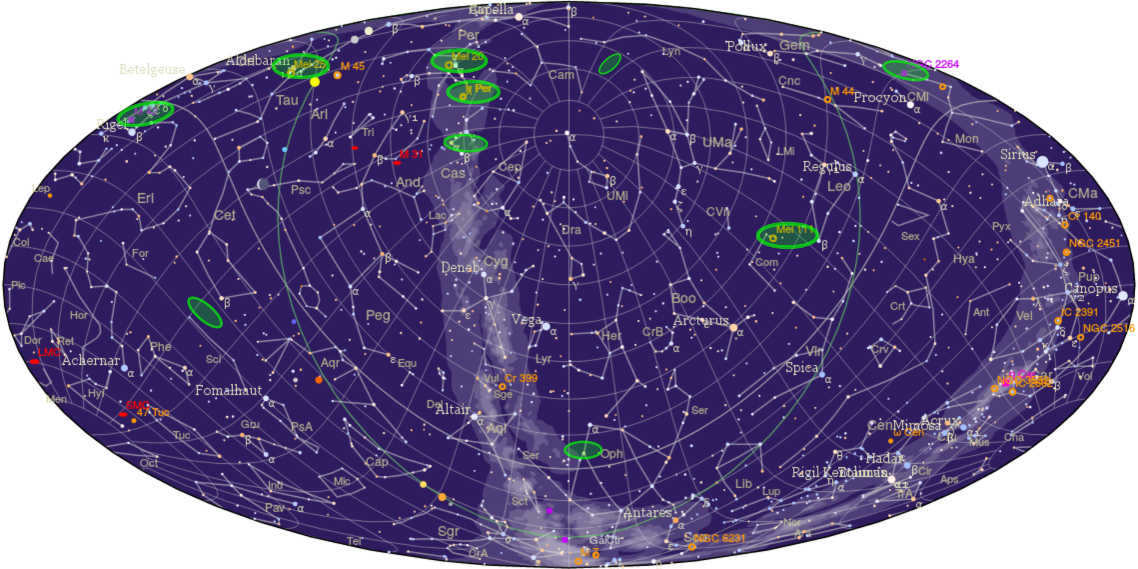
+7 926 604 54 63 address
We offer a selection of celestial objects that can be easily spotted and observed using binoculars or even just the naked eye. Instead of focusing on individual stars, we will be discussing “deep sky objects” (DSOs), which include nebulae, star clusters, and galaxies that are not too far away.
It is commonly believed that the unaided human eye is capable of observing celestial objects (such as stars and star clusters) in the night sky with apparent magnitudes of up to +6 and brighter. However, the use of ordinary field binoculars can significantly expand this range, allowing for the observation of objects with apparent magnitudes of up to +8 to +10, depending on the specific characteristics of the binoculars. It is important to note that in the stellar magnitude system, a smaller magnitude value indicates a brighter star. Therefore, the use of binoculars can enhance the brightness and clarity of the observed objects. This enhanced functionality enables observers to distinguish individual stars within a star cluster, which would otherwise appear as a hazy patch in the sky without the aid of binoculars. Additionally, binoculars can reveal that a seemingly singular point of light is actually a multiple star system, or even a larger cluster of stars. Overall, the use of binoculars greatly enhances the observational capabilities of the human eye in astronomy.
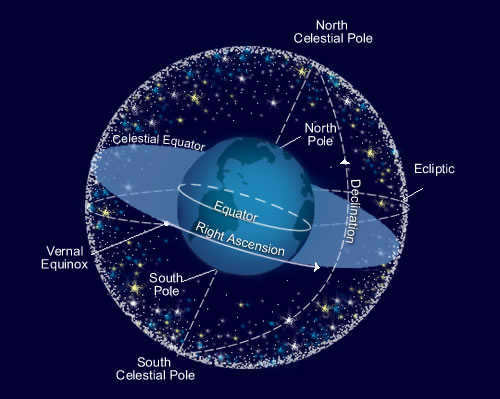
1. Hyades (Mel 25)
The group of stars known as Hyades, also referred to as Mel 25, is an interesting celestial formation.
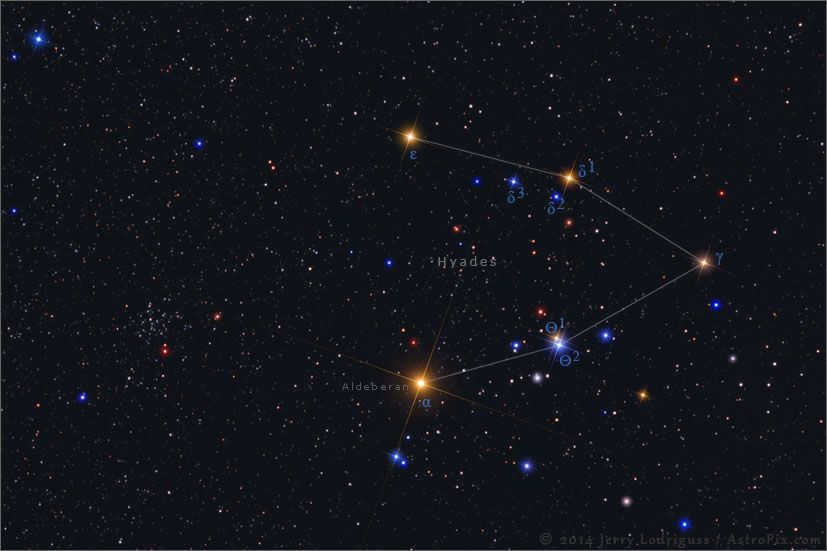
The constellation Orion is located in which galaxy?
Right Ascension: 4 hours 27 minutes, Declination: +15 degrees 52 minutes, magnitude: 0.5 m
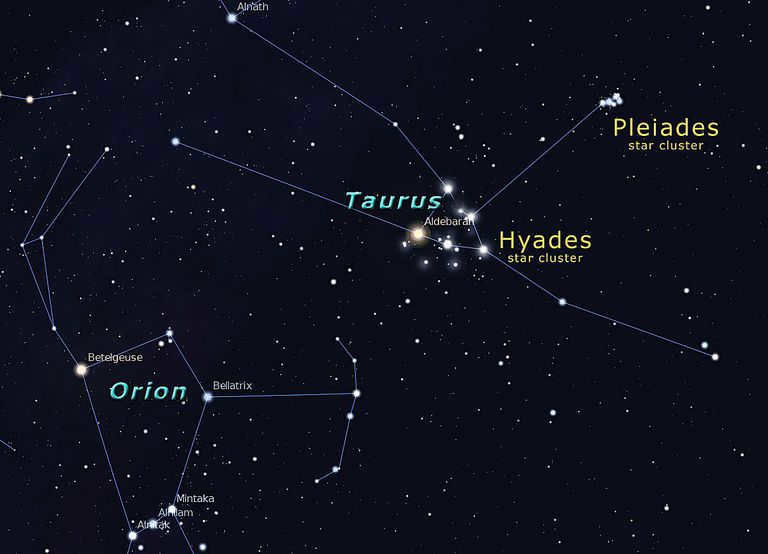
2. NGC 2264: Christmas Tree, Cone, Snowflake, and More
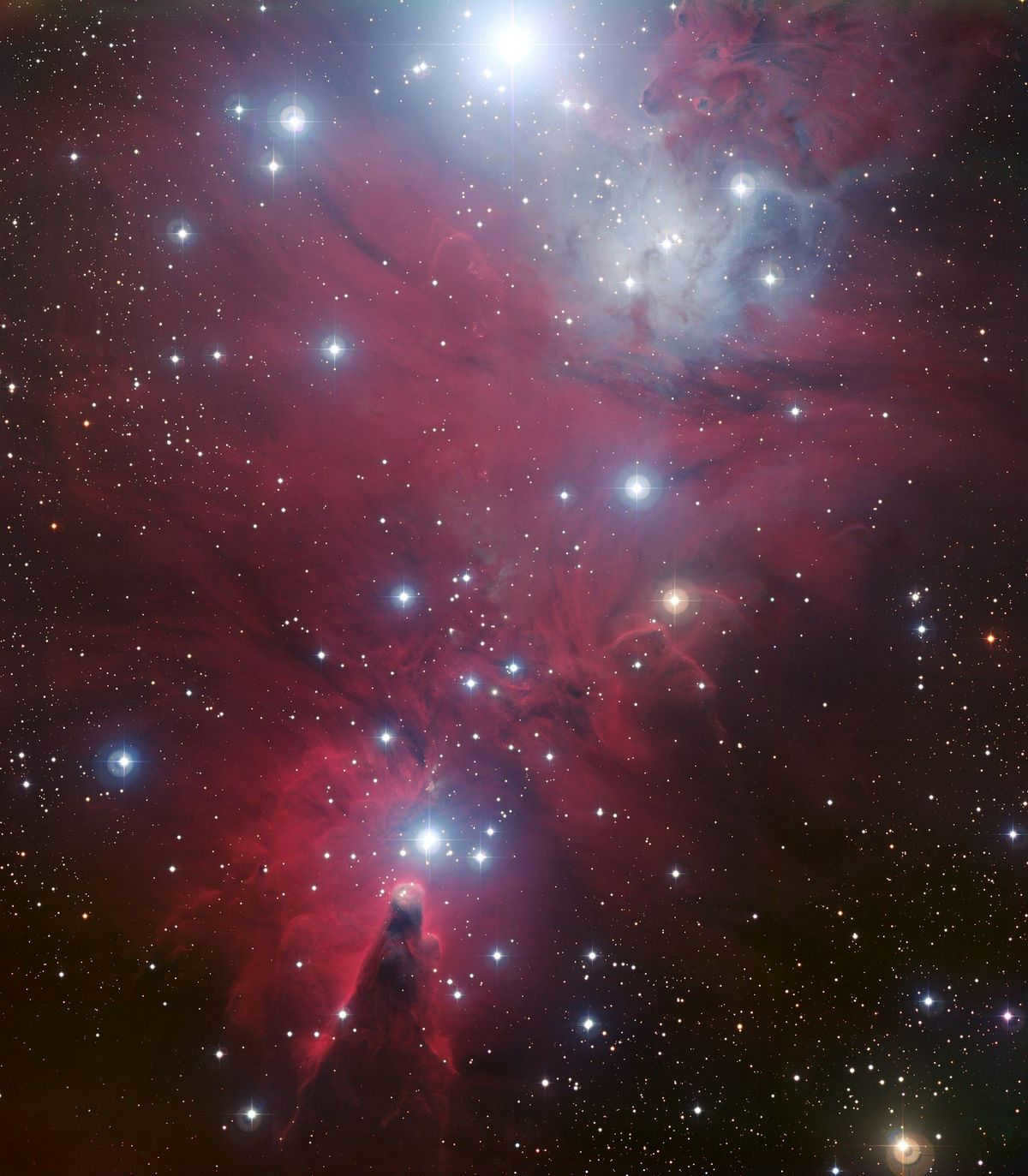
RA: 6h 41m, Decl: +9° 53″, magnitude 3.9 m
NGC 2264 can be found in the constellation Monoceros. It is positioned almost halfway between the stars Procyon and Betelgeuse, and is located near the Hyades and the well-known constellation Orion. It can also be easily identified by the “Winter Triangle” (Sirius – Procyon – Betelgeuse).

The New General Catalog (NGC) designation refers to various entities located in the same celestial region: the Cone Nebula (depicted below), the Christmas Tree Nebula (located above the Cone Nebula, albeit depicted upside down with its star at the apex), the Snowflake Nebula, and the Fox Fur Nebula. The diverse range of distinct objects in this area is a result of the emission nebula’s characteristics: a highly energetic star situated within a molecular gas cloud, which ionizes the cloud within a radius spanning hundreds of light-years. This process generates a luminous region of hydrogen plasma. Additionally, cooler sections of the same cloud serve as the birthplace for numerous young stars, forming a dispersed cluster and so forth.
The red hue in the image is a result of using pseudo-colors. Another spectral band, H-alpha, which represents the emission of hydrogen atoms and is significant for studying emission nebulae, was incorporated into the photo. H-alpha corresponds to the visible red color, but in astrophotography, a specific filter is utilized to isolate it and suppress other wavelengths. It is unlikely that such a range of colors will be visible through binoculars.
NGC 1981: The Orion Constellation’s Trio of Swords
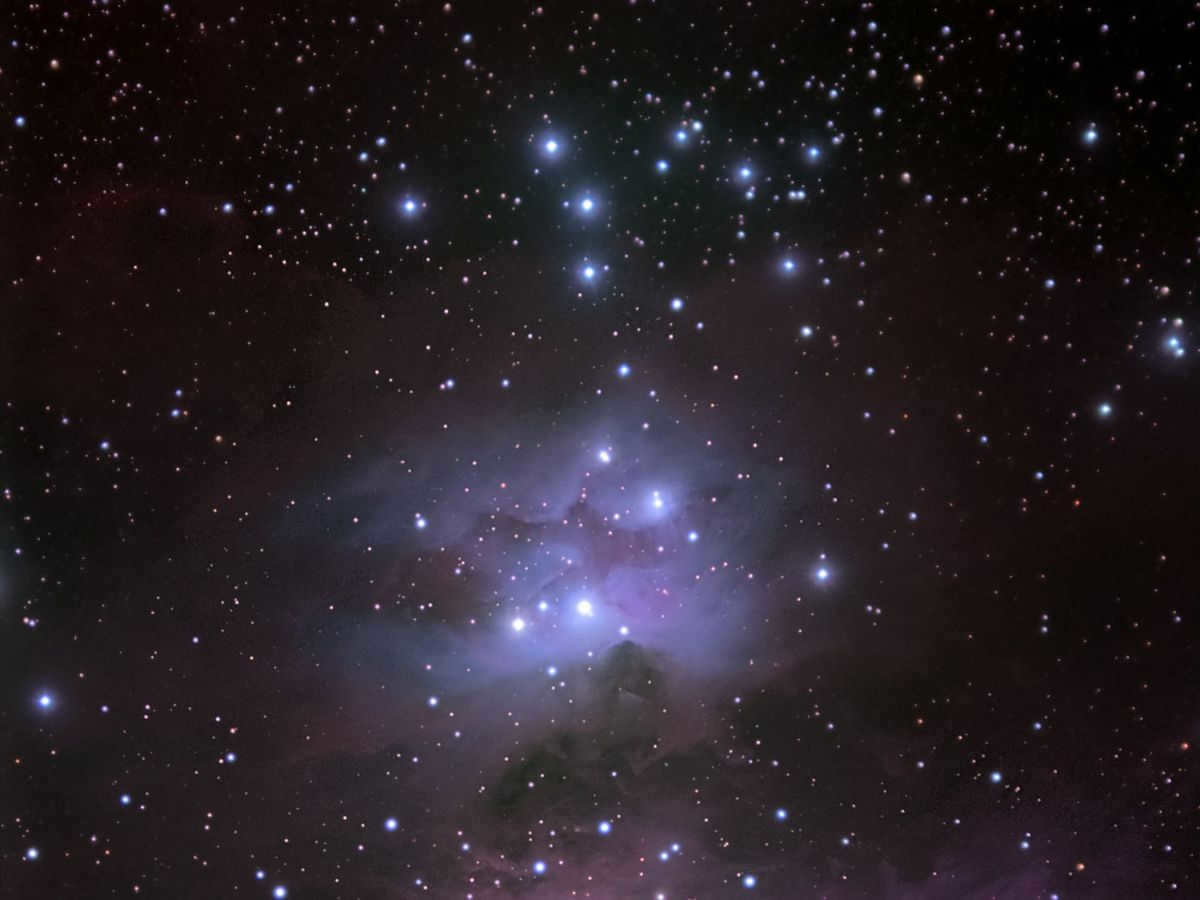
The constellation Orion is located in which galaxy? It is located in our Milky Way galaxy.
RA: 05h 35m 12 s, Decl: -04° 24′, mag 4.6 m

4. The Hive in the Summer (IC 4665, Mel 179)

The constellation Orion is located in the Milky Way Galaxy. Its coordinates are RA: 17h 46m 18s, Decl: +05° 43′, with a magnitude of 4.2 m.

5. NGC 2403 Galaxy

Right ascension (RA): 07 hours 36 minutes 51.4 seconds, Declination (Decl): +65 degrees 36 minutes 09 seconds, magnitude (mag): 8.9 m
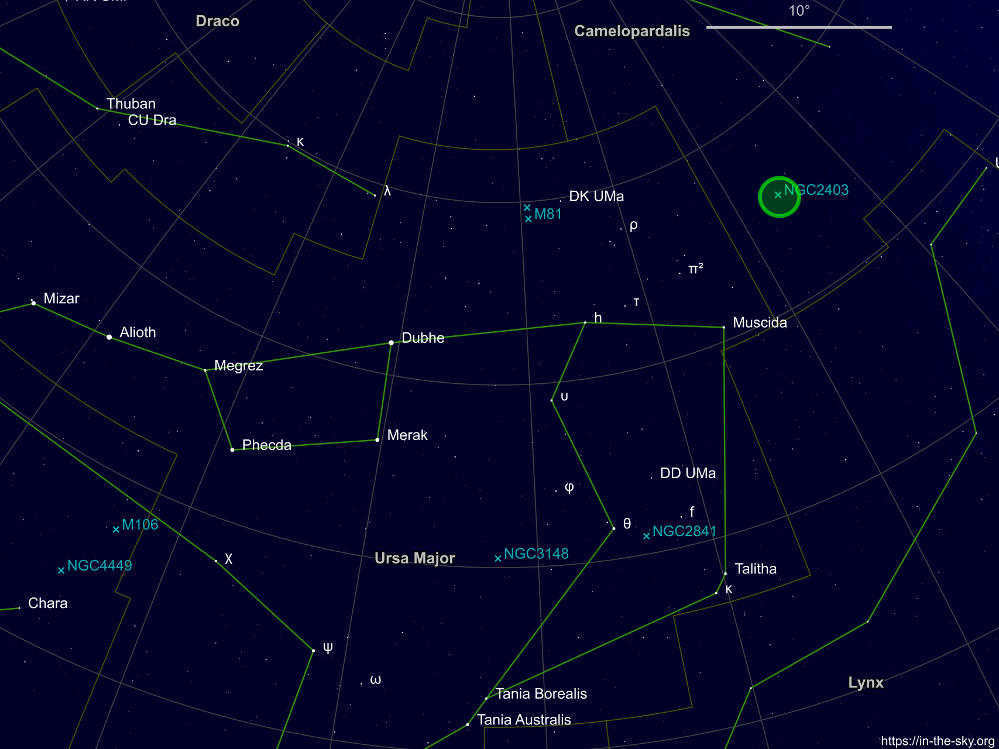
6. Alpha Perseus (Mel 20)
Alpha Perseus (Mel 20) is the sixth star in the constellation Perseus. It is also known as Mel 20. This star is located in the northern hemisphere and is visible from Earth. Alpha Perseus (Mel 20) has a spectral type of A2 and is classified as a main sequence star. It has a visual magnitude of 1.79, making it one of the brighter stars in the constellation. Alpha Perseus (Mel 20) is approximately 590 light-years away from Earth and has a radius of about 2.5 times that of the Sun.
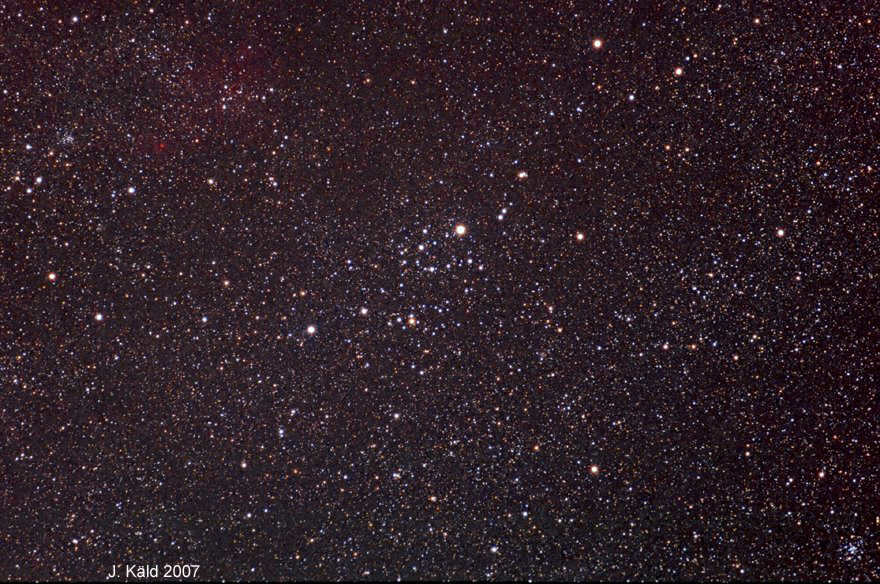
Right Ascension: 03h 26.9m, Declination: +49° 07′, magnitude 1.2 m
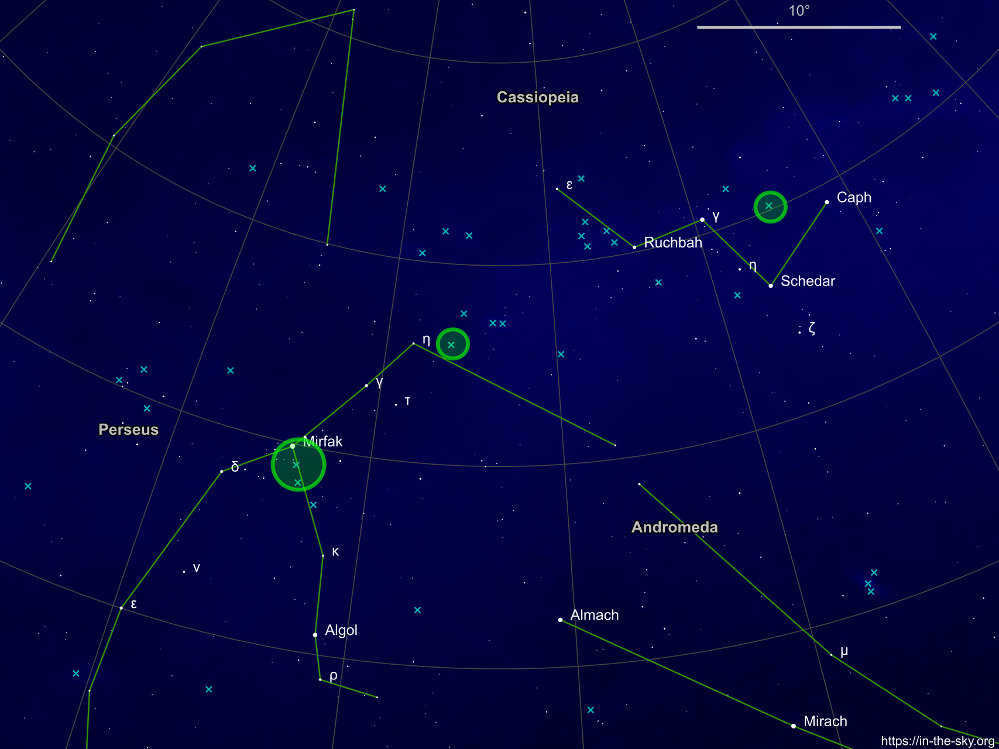
The young cluster located near the most luminous star in the Perseus constellation (known as Mirfak or α Perseus), is situated approximately 600 light-years away. It should be possible to observe a number of its brilliant blue stars with the naked eye. Similar to many other young clusters, these massive stars are classified as either O or B spectral types, and the cluster itself is categorized as an OB-association composed of stars originating from a shared source, moving in a moderately synchronized manner through space. Some of the prominent stars within the cluster, such as δ, σ, and ψ of Perseus, are part of the constellation’s recognizable pattern.
7. Rabbit (Trumpler 2)
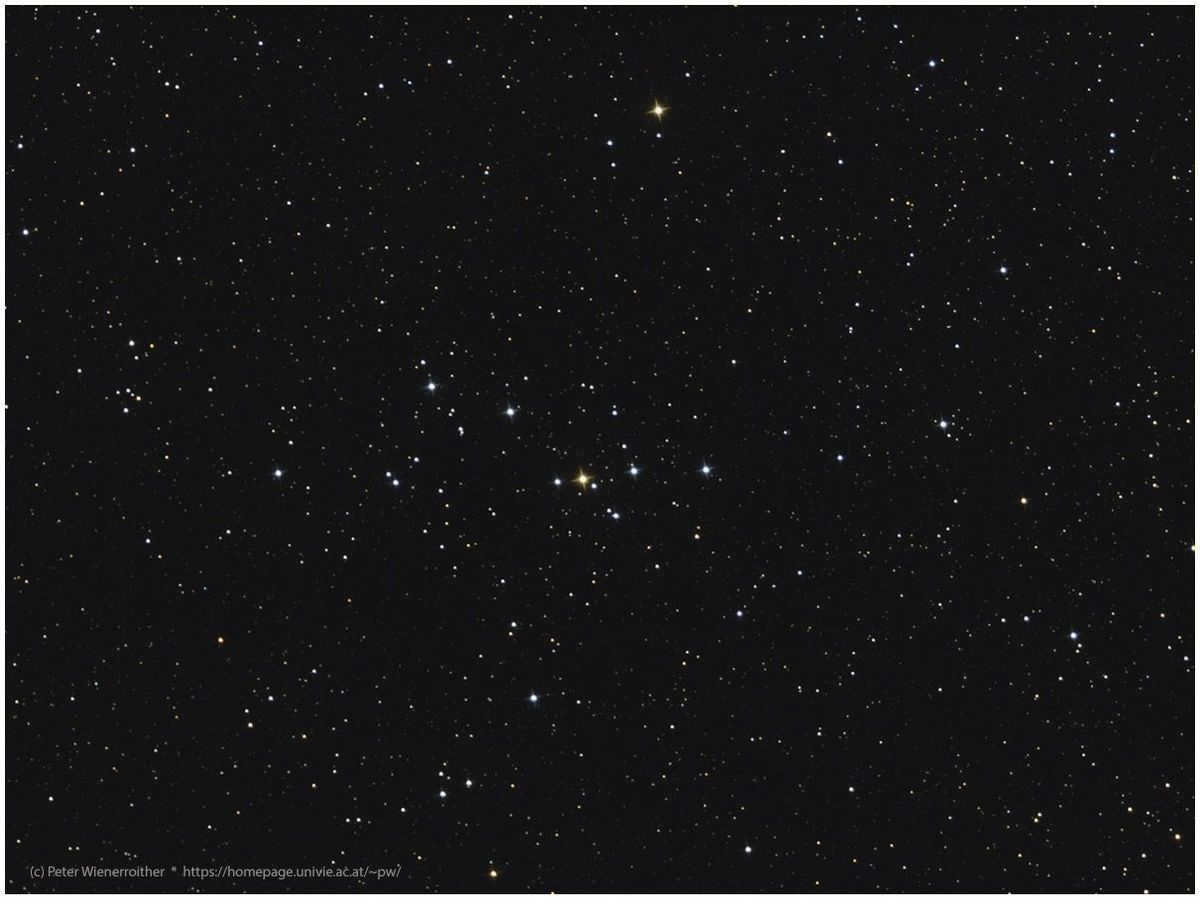
Right Ascension: 02h 36m, Declination: +55° 50′, magnitude: 5.9 m
8. NGC 129
NGC 129 is a celestial object located in the night sky. It is an interesting and unique phenomenon that has captivated astronomers for centuries. NGC 129 is known for its stunning beauty and intricate details that can be observed with the help of powerful telescopes. This celestial object is a great source of fascination and study for scientists, who continue to explore its mysteries and unravel its secrets. NGC 129 is a testament to the vastness and complexity of our universe, and it serves as a reminder of the infinite wonders that lie beyond our planet.
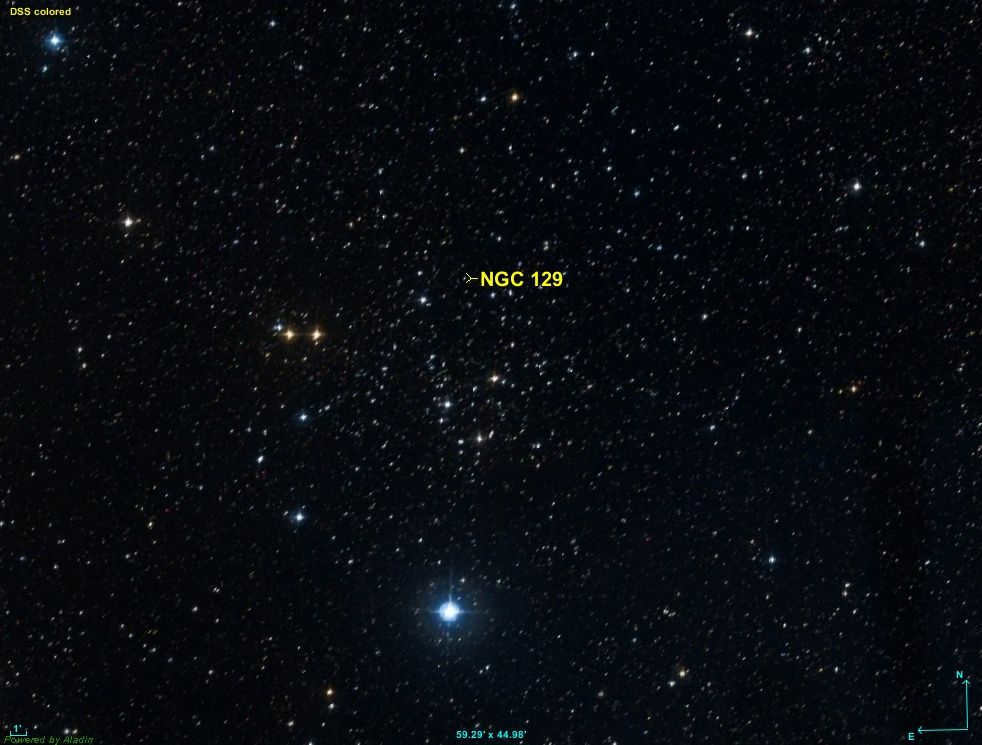

RA: 00h 30m, Decl: +60° 13′ 06″, magnitude 6.5 m
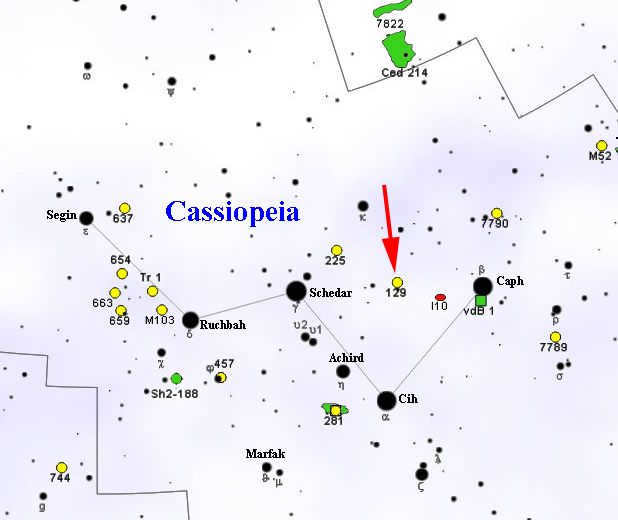
9. NGC 253, also known as the Silver Coin
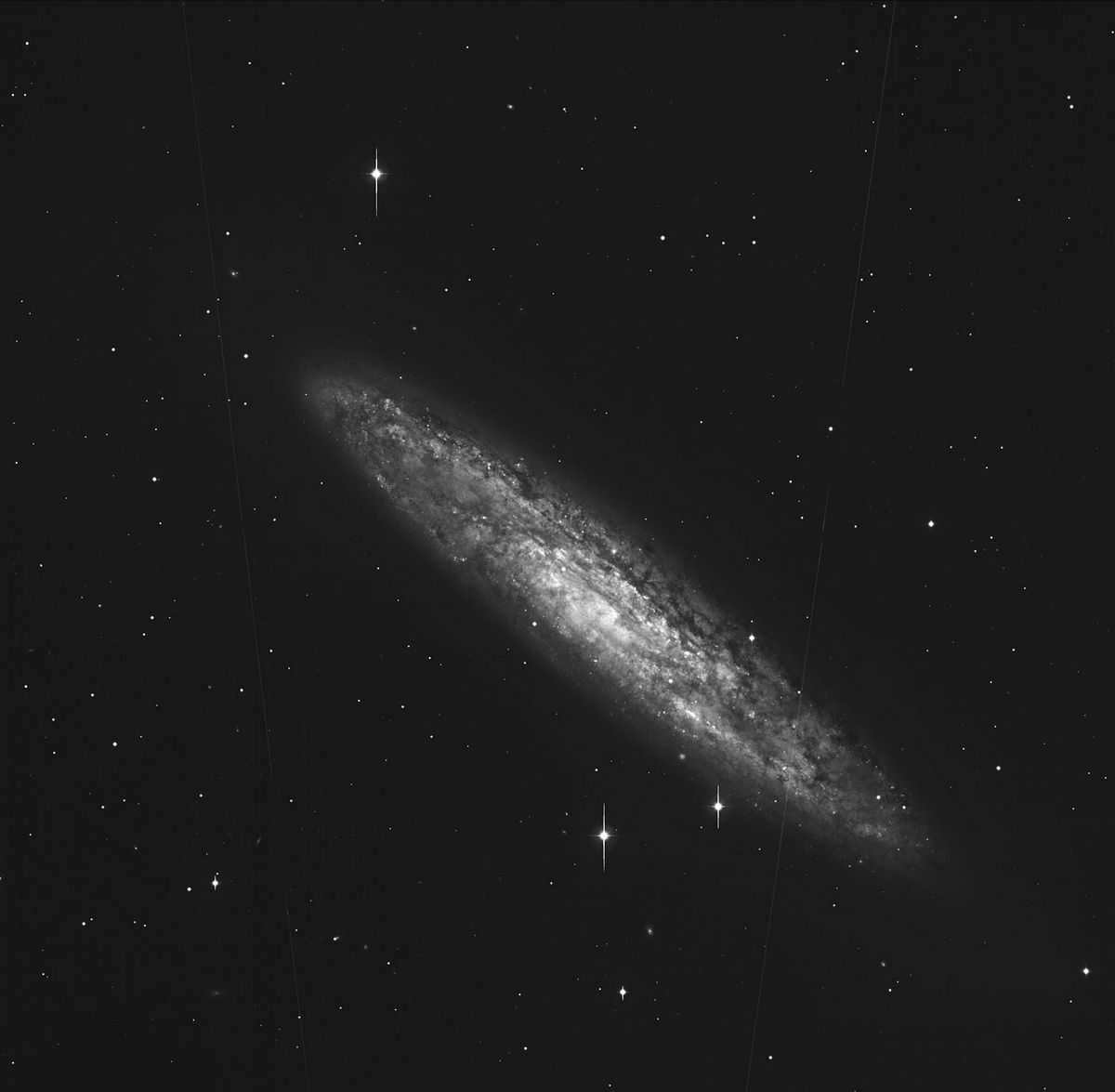
The constellation Orion is located in the Milky Way galaxy. Its right ascension is 00h 47m 33s, and its declination is -25° 17′ 18″. It has a magnitude of 8 m.
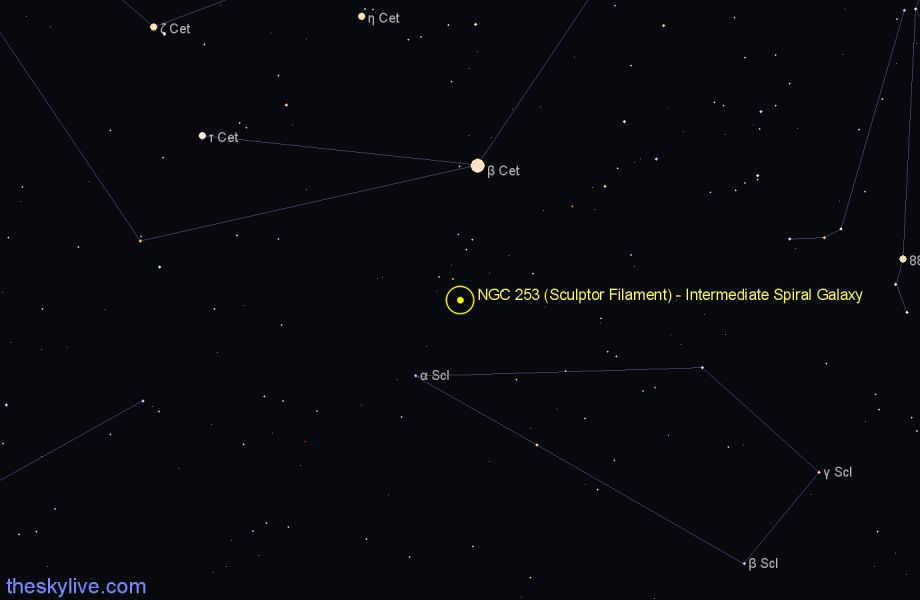
This particular spiral galaxy, located in the southern hemisphere, stands out as the most luminous among the group of galaxies known as the Sculptor group. It is in close proximity to the Local Cluster of galaxies and ranks among the most brilliant galaxies in the night sky, second only to the Andromeda Galaxy (M31). At present, it is undergoing a phase of vigorous star formation, which makes its X-ray and gamma-ray images particularly revealing. The galaxy is situated at a distance of approximately 11 million light years. In the optical range, we can observe some of its most dazzling stars, or rather, regions where new stars are being born, as well as an abundance of interstellar dust trails extending along its spiral arms – another indication of its active stellar processes. Within our own Galaxy, the closest counterparts to these regions can be found in the nebulae located in the constellations of Orion and Serpentor.
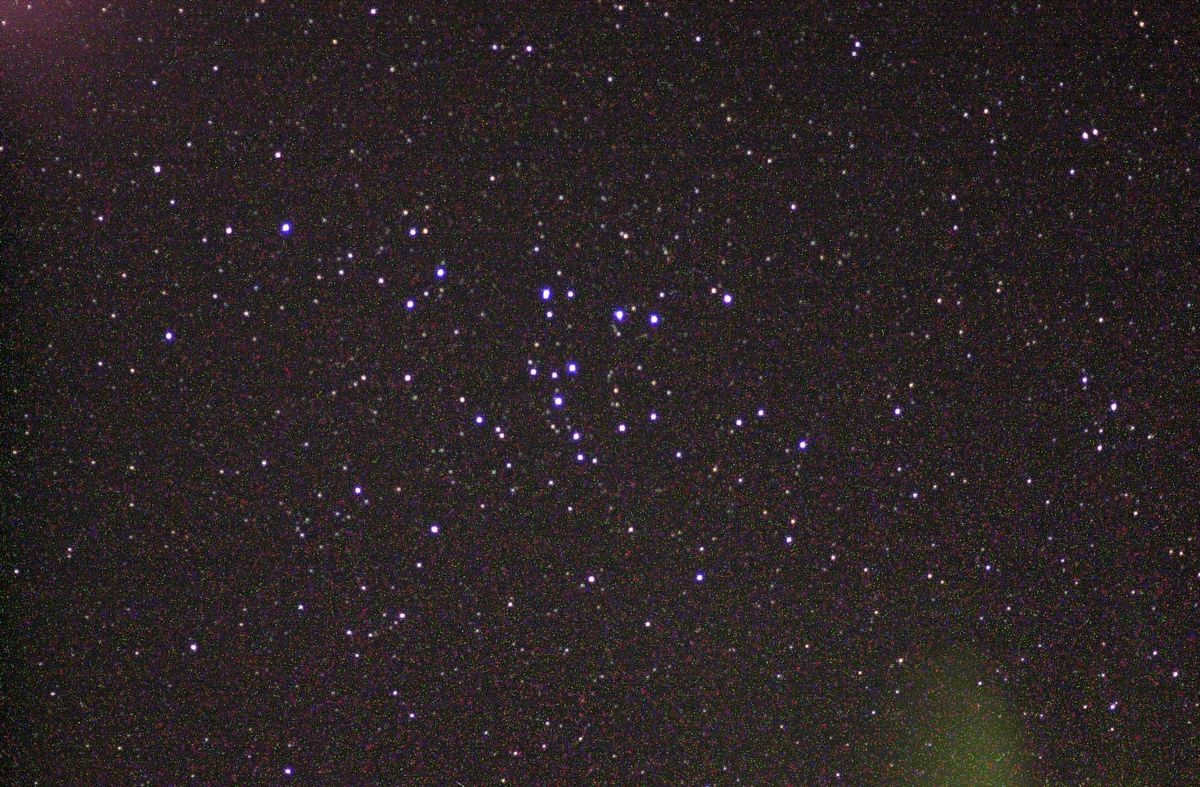
Right Ascension: 12 hours 22.5 minutes, Declination: +25 degrees 51 arcseconds, magnitude 1.8 m
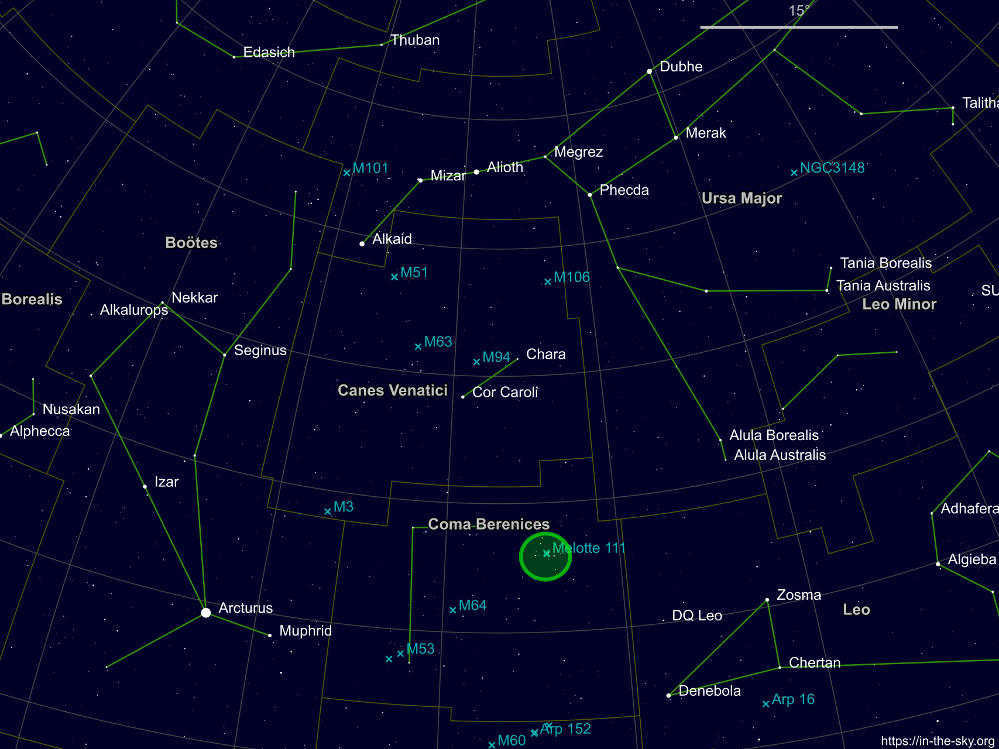
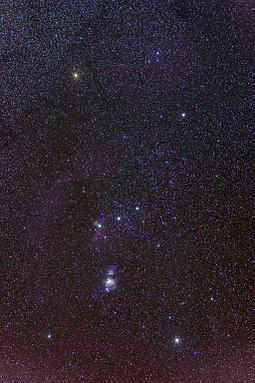
Orion is a well-known constellation that can be seen from anywhere in the world. It is easily recognizable and one of the most prominent constellations in the night sky. The name Orion comes from Greek mythology, where Orion was a hunter. The two brightest stars in Orion are Rigel, which is a blue-white star and Beta of Orion, and Betelgeuse, which is a red star and Alpha of Orion.
- 1 History and mythology
- 1.1 Ancient Near East
- 1.2 Greco-Roman antiquity
- 1.3 Middle East
- 1.4 China
- 1.5 India
- 1.6 European folklore
- 1.7 the Americas
- 1.8 Polynesian
- 1.9 Modern symbolism
- 1.10 Images
- 4.1 Bright stars
- 4.2 Belt
- 4.3 Sword
- 4.4 Head
- 4.5 Club
- 4.6 Shield
- 4.7 Meteor shower
- 4.8 Celestial Objects
- 7.1 Explanatory Notes
- 7.2 References
- 7.3 Literature
Origin and Legends
The earliest recorded depiction of the Orion constellation is an ancient carving on a mammoth bone discovered in a cave in West Germany in 1979. This carving, believed to be between 32,000 and 38,000 years old, showcases Orion’s iconic pattern. The constellation holds significance in various cultures worldwide and is the subject of numerous myths. Orion continues to be a symbol in modern society.
The Ancient Near East
In the late Bronze Age, the Babylonians had star catalogs that mentioned a constellation called Orion. They referred to it as “MUL SIPA.ZI.AN.NA,” which translates to “Heavenly Shepherd” or “True Shepherd Anu.” Anu is the chief god of the heavenly realms. Within the Babylonian constellation, there were two minor gods named Papshukal and Ninshubur, who were known as “messengers of the gods.” Papshukal was often associated with the walking bird depicted on Babylonian boundary stones. On the star chart, the constellation of the Rooster is positioned below and behind the figure of the True Shepherd. Both constellations represent the messenger of the gods, in their bird and human forms, respectively.
In ancient Egypt, the stars of Orion were worshipped as a deity named Sah. Sah was closely associated with Sopdet, the goddess who represented Sirius, as Orion rises before Sirius, which was the basis of the Egyptian solar calendar. Sopdu, the son of Sah and Sopdet, was considered a god. Sah was syncretized with Osiris, while Sopdet was syncretized with Osiris’ wife, Isis. According to the Pyramid Texts from the 24th and 23rd centuries BC, Sah was one of the gods whose form the deceased pharaoh would assume in the afterlife.
The Armenians believed that their legendary patriarch and founder, Hayk, was Orion. In the Armenian translation of the Bible, the constellation Orion is also referred to as Hayk.
In ancient Aram, the constellation was known as Nephila. The Nephilim are believed to be descendants of Orion.
Greco-Roman antiquity
In Greek mythology, Orion was a giant hunter with supernatural strength, born of Euryale, a Gorgon, and Poseidon (Neptune), the god of the sea. One myth recounts Gaea’s wrath towards Orion, who arrogantly claimed that he would kill all the animals on Earth. The furious goddess attempted to slay Orion with a scorpion. This is due to the fact that the constellations of Scorpio and Orion are never visible in the sky simultaneously. However, Serpentor revived Orion with an antidote. This is said to be the reason why the constellation of the Serpentine lies midway between Scorpio and the Hunter in the sky.
The constellation is mentioned in Horace’s Odes. by Horace (Ode 3.27.18), “Odyssey » Homer’s “Odyssey” (book 5, line 283) and “Iliad” as well as in Virgil’s Aeneid. Virgil (book 1, line 535).
Middle East
In medieval Muslim astronomy, Orion was known as al-jabbar. “giant.” Orion’s sixth brightest star, Saif, is named after the Arabic word for ” Saif al-jabbar “which means “sword of the giant”.
China
In China, Orion was one of the 28 lunar mansions known as Xieu (Siu) (宿). It is referred to as Shen (參) in honor of the stars comprising Orion’s Belt. (See Chinese constellations)
The Chinese character 參 (pinyin shen) originally represented the constellation Orion (Chinese: 參宿; pinyin: shenxiu); its Shang dynasty version, which is over three millennia old, features an image of the three stars that make up Orion’s belt on top of a man’s head (the lower part, representing the sound of the word, was added later).
India
In the ancient Indian text known as the Rigveda, the group of stars forming the constellation Orion is referred to as Mriga, which translates to “Deer”.

Nataraja, the celestial dancer, is often seen as a manifestation of Orion. Rudra, the ancient form of Shiva, is considered the supreme deity of the Ardra nakshatra (Betelgeuse) in Hindu astrology.
The Jain symbol found in the Udayagiri and Khandagiri caves in India during the 1st century BC bears a remarkable resemblance to Orion.
The Bugis sailors referred to the three stars in Orion’s Belt as tanra tellue, which translates to “the sign of the three”.
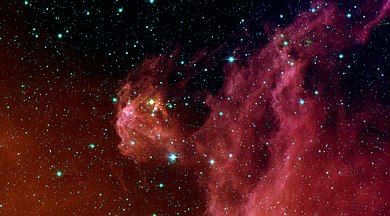
Star formation in the constellation of Orion, captured in infrared by NASA’s Spitzer Space Telescope.
In the ancient customs of Hungary, Orion is referred to as the (enchanting) Archer (Hunter) or the Reaper (Harvester). In recently uncovered legends, he is named Nimrod (Hungarian “Nimrod”), the supreme hunter, the father of the twins “Hunor” and “Magor”. The stars “π” and “o” (top right) together create a reflective bow or a raised scythe. In other Hungarian customs, Orion’s “belt” is known as the “rod of the judge” (Judge’s Staff).
In Scandinavian lore, Orion’s Belt was recognized as Frigg’s spinning wheel (friggerock) or spinning wheel Freya.
The Finnish people refer to Orion’s belt and the stars below it as Väinämöisen viikate (Väinämöinen’s scythe). Another name for this group of stars is Alnilam, Alnitak, and Mintaka. It is also known as Väinämöisen vö (Väinämöinen’s belt), and the stars that appear to hang from the belt are called Kalevanmiekka (Kaleva’s sword).
In Siberia, the Chukchi people see Orion as a hunter, and the arrow that he fires is represented by Aldebaran (Alpha Taurus), which is depicted similarly in Western images.
United States
The Seri tribe of northwestern Mexico has designated three stars in Orion’s belt as Hapj (a name associated with a hunter), which consists of three stars: Hap (mule deer), Haamoja (and Modjet (snow sheep). Hap is positioned in the center and was struck by a hunter; his blood fell onto Tiburon Island.
These same three stars are recognized in Spain and many parts of Latin America as “Las tres Marías” (Spanish for “The Three Marys”). In Puerto Rico, the three stars are referred to as “Los Tres Reyes Magos” (Spanish for “The Three Wise Men”).
The Ojibwa (Chippewa) Native Americans refer to this constellation as Cabibona’kan, which means the Creator of Winter, as its appearance in the night sky signals the arrival of winter.
The Lakota Native Americans believe that Taiamnicanhu, which is Orion’s Belt, represents the spine of the bison. The Great Rectangle of Orion is said to be the ribs of the buffalo, while the Pleiades star cluster in the neighboring Taurus constellation is seen as the buffalo’s head. In addition, Sirius in the constellation of the Big Dog, known as Tyamnicinte, is considered to be the buffalo’s tail. According to another Lakota myth, the lower half of Orion, known as the Constellation of the Hand, represents the hand of a chief. The hand was torn off by the Thunderers as punishment from the gods for the chief’s selfishness. However, the chief’s daughter offered to marry anyone who could retrieve his hand from the heavens. Eventually, a young warrior named Fallen Star, who had a star for a father and a human for a mother, returned the hand and married the chief’s daughter. This symbolized the harmony between the gods and mankind. In this myth, Rigel represents the index finger, the Orion Nebula represents the thumb, Orion’s belt represents the wrist, and the star Beta Eridanus represents the little finger.
Polynesian
The constellation Heiheionakeiki, which represents a child’s figure made of thread that resembles a cat’s cradle, is formed by the seven main stars of Orion in Polynesian culture.
Modern symbolism
The belt and sword of Orion have become symbols in popular Western culture. For example, the U.S. Army’s 27th Infantry Division, known as the “Orion Division,” used the constellation as part of its shoulder insignia during both World Wars. This may have been influenced by a pun on the name by the division’s first commander, Maj. Gen. John F. O’Ryan.
The movie distribution company Orion Pictures adopted a constellation as its logo.
graphics
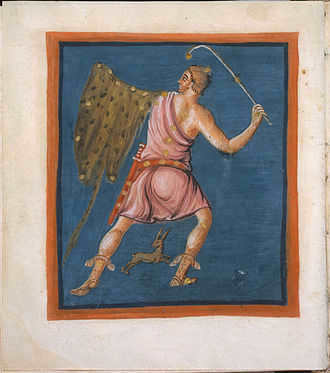
When it comes to artistic depictions, Orion is often linked to the surrounding constellations. These representations show him standing next to the Eridanus River, accompanied by his two hunting dogs, Big Dog and Little Dog, as he battles Taurus. Alternatively, he can be seen hunting the hare Lepus. Another portrayal shows him holding a lion skin in his hand.
There are various ways to visualize Orion. When observed from the Southern Hemisphere, Orion appears with its south side up. In Australia and New Zealand, the belt and sword of Orion are sometimes referred to as the pot. Afrikaans speakers in South Africa call Orion’s belt the “Drie Konings” or “Drie Susters” (Three Sisters). In the book “Lettres de Mon Moulin” by Daudet (1866), they are mentioned as “les Trois Rois” (Three Kings). In 17th and 18th century Dutch star charts and sailors’ handbooks, they are often labeled as “Drikoningen” (Three Kings). In Spain, Latin America, and the Philippines, the same three stars are known as “Las Tres Marías” (The Three Marys), and in Puerto Rico, they are called “Los Tres Reyes Magos” (The Three Wise Men).
There were significant variations in the traditional depictions of Orion. In Cicero’s depiction, he was shown in a similar way to the modern depiction. He was depicted holding the skin of an unknown animal in his right hand, with Omicron 2 Orionis representing his hand and Pi Orionis representing the skin. Kappa and Beta Orionis represented his left and right knee, while Eta and Lambda Leporis represented his left and right feet, respectively. Delta, Epsilon, and Zeta represented his belt, Alpha Orionis represented his left shoulder, and Mu Orionis represented his left arm. His head was depicted as Lambda Orionis, and his right shoulder was represented by Gamma. Hyginus’ depiction was similar to Cicero’s, but with some notable differences. Instead of an animal skin, Hyginus depicted Orion with a shield (represented by Omicron and Pi Orionis), and he held a club (Chi Orionis) instead of a hand (marked by Mu Orionis). Theta Orionis represented his right leg, and Lambda, Mu, and Epsilon Leporis represented his left leg. These two models were followed by further depictions in Western Europe and the Arabic tradition.
Distinctive Features
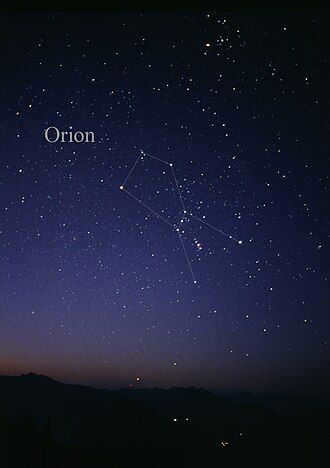
Orion is surrounded by different constellations in various directions. It is bordered by Taurus to the northwest, Eridanus to the southwest, Lepus to the south, Unicorn to the east, and Gemini to the northeast. With an area of 594 square degrees, Orion is ranked as the twenty-sixth largest constellation out of the 88 constellations. The boundaries of Orion were established by Belgian astronomer Eugène Delporte in 1930, and they are defined by a polygon with 26 sides. In the equatorial coordinate system, Orion’s right ascension coordinates range from 04 h 43.3 m to 06 h 25.5 m, while its declination coordinates range from 22.87° to -10.97°. The International Astronomical Union adopted the three-letter abbreviation “Ori” for Orion in 1922.
The best time to observe Orion is during the evening sky from January to April, which corresponds to winter in the Northern Hemisphere and summer in the Southern Hemisphere. In regions near the equator (within 8°), the constellation can be seen directly overhead.
Between the months of May and July, which correspond to summer in the Northern Hemisphere and winter in the Southern Hemisphere, the constellation Orion is positioned in the daytime sky, making it invisible to most observers around the world. However, in the winter months of the Southern Hemisphere, particularly in Antarctica, the Sun remains below the horizon even at noon. This unique phenomenon allows for the stars, including Orion and its brightest stars, to become visible during dusk for a few hours around noon local time. They can be seen low in the northern part of the sky, where the Sun is just below the horizon. Interestingly, at the Amundsen-Scott South Polar Station located at the South Pole itself, the star Rigel appears at an elevation of only 8° above the horizon, with the Belt of Orion passing just above it. On the other hand, during the summer months of the Southern Hemisphere when Orion is typically visible in the night sky, the constellation is not actually observable in Antarctica because the sun does not set south of the South Polar Circle during this time of year.
Help with Navigation
Orion serves as a valuable tool for locating other stars. By extending the line of the Belt to the southeast, you can find Sirius (α CMa); by going northwest, you’ll come across Aldebaran (α Tau). If you draw a line eastward through Orion’s shoulders, it will point you towards Procyon (α CMi). Another line can be drawn from Rigel through Betelgeuse, which will lead you to Castor and Pollux (α Gem and β Gem). Rigel is also part of the Winter Circle asterism. Both Sirius and Procyon, which can be located using imaginary lines from Orion (refer to the map), are also part of the Winter Triangle and the Circle.
Functions
In the world of programming, functions play a vital role. Functions are blocks of code that perform a specific task. They can take in input, perform calculations or operations, and return output.
Functions can be thought of as reusable building blocks that can be used to simplify and modularize code. Instead of writing the same code over and over again, functions allow us to write it once and reuse it wherever needed.
In many programming languages, including Python, functions are defined using the keyword “def”. The syntax for defining a function in Python is as follows:
“`
def function_name(parameters):
# code block
return output
“`
Here, “function_name” is the name of the function, and “parameters” are the inputs that the function takes. Inside the code block, you can perform any desired operations using the input parameters. The “return” statement is used to output the result of the function.
Functions can be called by their name followed by parentheses. Any required arguments can be passed inside the parentheses. The function will execute the code block and return the output.
Using functions can greatly enhance the readability and maintainability of code. They allow for code reusability and can make complex tasks more manageable. By breaking down a program into smaller functions, it becomes easier to understand and debug.
In conclusion, functions are a fundamental concept in programming that allow for code organization and reusability. They are an essential tool in any programmer’s toolbox.
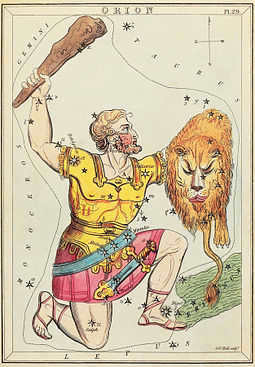
The constellation Orion can be seen in the night sky as depicted in the 1825 publication, “The Mirror of Urania”.
Orion’s Belt is formed by three stars – Alnitak, Alnilam, and Mintaka – which are located in the center of a larger rectangular shape created by four other bright stars – Rigel, Betelgeuse, Bellatrix, and Cyphus. Descending from the Belt is a line of three stars known as the Sword of Orion, with the center of the Sword being the Orion Nebula. This configuration is often referred to as the Hunter’s Sword.
There are numerous luminous hot blue supergiants among the stars, and the stars in the belt and sword shape the Orion association OB1. Although Betelgeuse stands out with its red hue, it might actually be a runaway member of the same group.
Shining stars
- Betelgeuse, also known as Alpha Orionis, is a massive M-type red supergiant star that is approaching the end of its lifecycle. It is the second most luminous star in the constellation Orion and is classified as a semi-regular variable star. It is situated at the “right shoulder” of the celestial hunter it represents (when facing the observer). Normally, it ranks as the eleventh brightest star in the night sky, although its brightness has varied between the tenth and twenty-third positions in 2019. Scientists predict that Betelgeuse will eventually undergo a supernova explosion, which will be clearly visible from space and may even outshine the moon, possibly even during daytime. This spectacular event is expected to occur within the next 100,000 years.
- Johann Bayer designated Bellatrix as Gamma Orionis. It is the twenty-seventh most luminous star in the night sky. Bellatrix is classified as a B-type blue giant star, although its size prevents it from undergoing a supernova explosion. The brightness of Bellatrix is a result of its high temperature, rather than its large size. Bellatrix is located on Orion’s left shoulder and is often informally known as the “Warrior Woman” or the “Star of the Amazon”. It is the nearest significant star to Orion, situated 244.6 light-years away.
- Mintaka, despite being the dimmest of the three stars in Orion’s Belt, is designated as Orion’s Delta. Its name, which means “belt,” adds to its significance. The Mintaka system is composed of a large blue B-type giant and a more massive O-type main-sequence star, forming a multiple star system. This system is known as an eclipsing double variable star, as one star eclipses the other, resulting in a decrease in brightness. Mintaka holds the position of the westernmost star in Orion’s Belt and is also the northernmost star.
- Epsilon Orionis, also known as Alnilam, derives its name from an Arabic phrase that translates to “string of pearls”. Positioned in the middle, it is the most luminous among the three stars in Orion’s Belt. Alnilam, a blue B-type supergiant, holds an almost equal magnitude to its closer counterparts, despite being nearly twice as distant from the Sun. Due to its size, Alnilam is experiencing rapid mass loss. As the furthest massive star in Orion, it lies at a distance of 1,344 light-years.
- Alnitak, referred to as Orion’s Zeta, signifies “belt” and stands as the easternmost star in Orion’s Belt. This star system consists of three stars, with its primary star being a scorching blue supergiant and the brightest O-class star visible in the night sky.
- The star known as the “Bayer” of Kappa Orionis is Cyphus, and it occupies the position of Orion’s right foot. It has the same size and distance as Rigel, but it appears much fainter. Its name, “sword of the giant,” is derived from its symbolism.
- Meissa, identified as Orion’s Lambda, is located at the head of Orion. It is a multiple star system with a combined apparent magnitude of 3.33. The name Meissa signifies its radiance and brilliance.
Orion’s Belt
The asterism known as Orion’s Belt is composed of three bright stars: Zeta (Alnitak), Epsilon (Alnilam), and Delta (Mintaka). Alnitak is located approximately 800 light years away from Earth and is 100,000 times brighter than the Sun. However, most of its radiation falls within the ultraviolet range, making it invisible to the human eye. Alnilam, on the other hand, is situated about 1,340 light years away and shines with a magnitude of 1.70. It is an impressive 375,000 times brighter than the Sun in ultraviolet light. Mintaka, the third star in Orion’s Belt, is located 915 light-years away and has a stellar magnitude of 2.21. It is 90,000 times brighter than the Sun and is actually a double star, with both stars orbiting each other every 5.73 days. In the Northern Hemisphere, the best time to observe Orion’s Belt in the night sky is in January around 9:00 p.m. when it approximately aligns with the local meridian.
To the southwest of Alnitak, there is a star system called Sigma Orion. This system consists of five stars with a combined apparent magnitude of 3.7 and is located 1150 light-years away. On the other hand, if we look to the southwest of Mintaka, we will find the quadruple star Eta Orion.
Constellation
Star System
In the constellation of Orion, the head is marked by a small triangle formed by three stars. At the apex of this triangle, we can find Meissa (Lambda Orionis), which is a hot blue giant with a spectral class of O8 III and an apparent magnitude of 3.54. Meissa is situated approximately 1,100 light-years away. The core of the triangle is made up of Phi-1 and Phi-2 Orionis. Additionally, in close proximity to this area, there is a very young star called FU Orionis.
Club
Orion’s club is composed of the stars located to the north of Betelgeuse. The elbow is marked by Mu Orionis, while the handle of the mace is formed by Nu and Xi. The end of the mace is indicated by Chi 1 and Chi 2. Just east of Chi 1, you can find a variable red giant known as Mira U Orionis.
Shield
Orion’s shield consists of six stars located west of Bellatrix. These stars are designated as Orion’s Pi, including π 1 Orion, π 2 Orion, π 3 Ori, π 4 Ori, π 5 Ori, and π 6 Orion.
Meteor shower
The Orionid meteor shower, known as the Orionids, reaches its maximum activity around October 20th every year. From the area near the Gemini constellation, it is possible to observe up to 20 meteors per hour. This meteor shower is associated with the debris left behind by Halley’s Comet.
Deep Space Objects
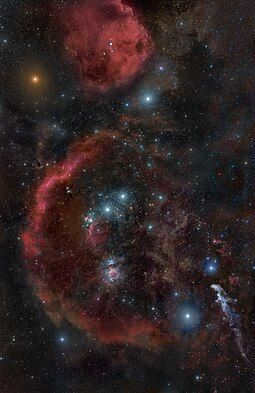
The constellation of Orion is home to a fascinating feature known as the Orion Nebula (M42), as well as a cluster of stars called the Trapezium. This cluster is made up of many of Orion’s θ1 and θ2 stars, and it is a remarkable sight that can be easily seen with the naked eye. When viewed through binoculars, you can observe the clouds of nascent stars, glowing gas, and dust that make up the nebula. The Trapezium cluster is located approximately 1500 light-years away and is filled with newborn stars, including several brown dwarfs. These stars are all around 1500 light-years away from us and are illuminated by the brightest stars in the cluster. These bright stars are only a few hundred thousand years old. The Chandra X-ray Observatory has provided observations that reveal the extreme temperatures of the main stars in the cluster, reaching up to 60,000 kelvin. Additionally, these observations show that there are still areas of star formation occurring within the surrounding nebula.
IC 434, also known as the Horsehead Nebula, can be found near ζ Orion. It is home to a dark dust cloud that has given the nebula its distinctive shape.
Located 6400 light-years away from Earth, NGC 2174 is an emission nebula.
Exploring Orion with a small telescope will reveal numerous captivating celestial objects, including M43, M78, and notable stars like Orion’s Iota and Orion’s Sigma. With a larger telescope, one can even observe objects such as Barnard’s Loop and the Flame Nebula (NGC 2024), as well as dimmer and more compact multiple stars and nebulae.
All of these nebulae are part of the expansive Orion molecular cloud complex, which stretches across hundreds of light-years and is situated approximately 1500 light-years away. This region is renowned for being one of the most active areas of star formation within our galaxy.
The future
An animation is presented here that illustrates the movement of Orion over a span of time from 50,000 B.C. to 50,000 A.D. Notably, Pi3 Orionis exhibits the highest speed among all the stars in Orion.
Orion currently resides on the celestial equator, but it will eventually change its position due to the Earth’s axis precession. It is worth mentioning that Orion is situated considerably south of the ecliptic and exclusively on the celestial equator. This is because the point on the ecliptic that corresponds to the June solstice is positioned near the boundary between the Gemini and Taurus constellations, which is north of Orion. As time progresses and precession takes effect, Orion will gradually move further south. By the year 14000 A.D., Orion will have shifted so far south that it will no longer be observable from locations within the latitude of Great Britain.
Over time, the stars within the Orion constellation will slowly separate from one another as a result of their individual movements. Nevertheless, when comparing distances in astronomical terms, all of Orion’s most brilliant stars are located much farther away from Earth than Sirius, for instance. As a result, Orion will remain identifiable long after the majority of other constellations, comprised of stars that are relatively close by, have transformed into new formations. However, a select few stars within Orion, including Betelgeuse, are expected to eventually go supernova and explode. In fact, it is predicted that Betelgeuse will undergo a supernova event within the next one million years.
Additional Resources
- Euroion Constellation
- Hubble 3D (2010), an IMAX film that showcases a sophisticated computer-generated “fly-through” of the Orion Nebula.
- Orion in Chinese Astronomy
- Orion Correlation Theory
- Orvandil
- Urania
- Winter Hexagon
References
Explanation
Quotes
Works Cited
- Levy, David H. (2005). Deep space objects. Prometheus Books. ISBN1-59102-361-0.
- Ian Ridpath and Wil Tirion (2007). A guide to the stars and planets, Collins, London. ISBN978-0-00-725120-9. Princeton University Press, Princeton. ISBN978-0-691-13556-4.
- Staal, Julius D.W. (1988), New patterns in the sky, McDonald and Woodward Publishing Company, ISBN0-939923-04-1
Outbound link

The Orion Nebula is arguably one of the most stunning and luminous nebulae in the night sky. It is an expansive cluster of ionized hydrogen and serves as a hub for active star formation. Positioned at a distance of 1344 light-years, with a span measuring 33 light-years and an angular size of 80×60 minutes, it boasts an apparent stellar magnitude of +4.0. This celestial wonder was initially sighted by the French astronomer Fabry de Peyresque Nicolas-Claude on November 26, 1610.
Remarkably, the Orion Nebula can be easily observed without the assistance of a telescope, as it is clearly visible to the naked eye just below the “Orion belt”. The optimal time for viewing is during the winter months, although observations can be conducted from November through March. Additionally, M42 can also be observed in the summer, just before dawn.
The Great Orion Gas-Dust Nebula is the nearest region to Earth where new stars are being born, consisting of gas and dust. M42 is a breeding ground for stars, and astronomers have identified approximately 700 stars that are currently undergoing formation within this nebula.
M42 is a diffuse type of nebula that lacks its own energy source, unlike stars. The illumination within it is caused by hot stars that are either located within the nebula or in close proximity to it. The Great Orion Nebula is composed of material that did not contribute to the formation of these stars.
M42 appears mostly red in color due to the abundance of hydrogen present in it. Blue and green tints indicate the presence of other elements such as helium, nitrogen, heavy metals, sulfur, and oxygen.
At the heart of M42, there exist four brilliant blue stars, arranged in the configuration of a trapezoid. Every single star radiates its own luminous glow, and the celestial matter present in the surrounding space absorbs this radiance and reflects it back in a unique hue.
The presence of dust clouds in M42 gives rise to intricate fiber-like formations, as well as intriguing structures resembling leaves and bubbles. The forceful stellar winds exert their influence on the surrounding cloud formations, causing them to take on a gracefully curved appearance.

14.9K posts 45.3K subscribers
Community Guidelines
What guidelines could exist here, apart from the guidelines established by the peekaboo itself 🙂
There was a film in the Soviet Union called “Orion’s Loop”. It was a work of fiction.


August 18, 2023, 00:01 – Saturn Time.
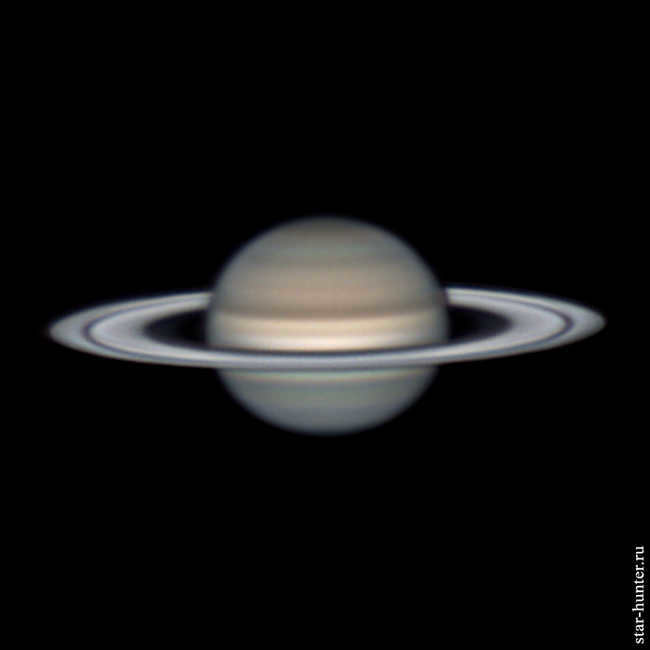
Equipment Used:
-Sky-Watcher Dob 14 (350/1600) Retractable SynScan GOTO telescope
-Lensblock Barlow NPZ PAG 3-5x
-atmospheric dispersion corrector ZWO ADC
-ZWO IR-cut light filter
-astronomical camera ZWO ASI 183MC.
Observatory Location: Caucasus Mountain Observatory, Moscow State University, Karachay-Cherkess Republic.
Here is a segment from the original video:

Photographing the Jellyfish Nebula in three distinct narrow band filters
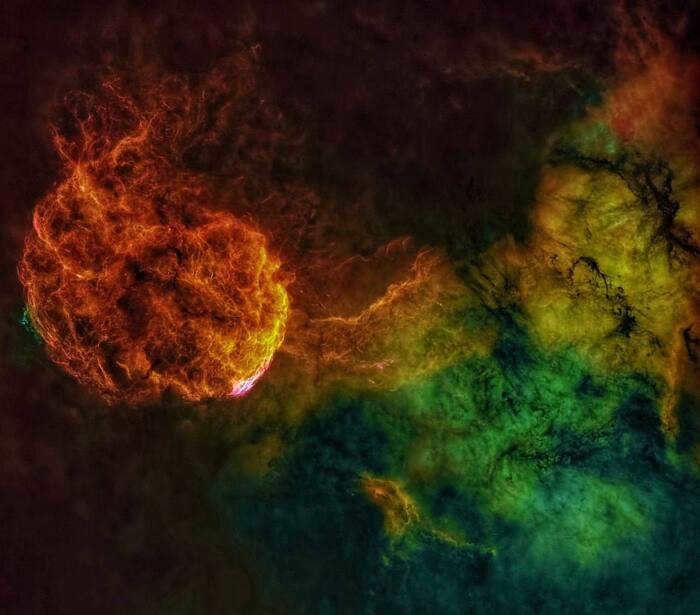
Various Perspectives of the Milky Way

Comet C/2023 P1 (Nishimura) – a celestial phenomenon on the horizon.
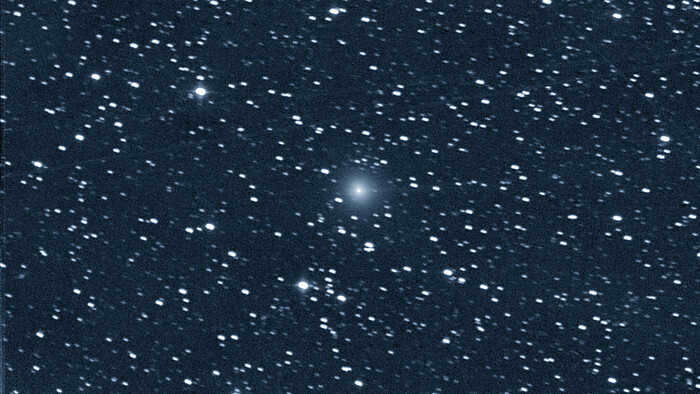
Comets are unexpected visitors. While the old ones, known to us for a long time, can be disappointingly underwhelming (which is not surprising, as they have had time to deplete and melt during repeated approaches to the Sun), newly discovered comets are often bright and spectacular. However, this is not always the case.
The comet C/2023 P1 was spotted by the Japanese astronomer Hideo Nishimura on the night of August 11-12, 2023. The comet was located in the constellation Gemini (where it can still be found). It can be said that the discovery of the comet was a stroke of luck, as finding a faint, nebulous object (with a magnitude of 12) in the brightening pre-dawn sky requires great luck and demonstrates exceptional professionalism.
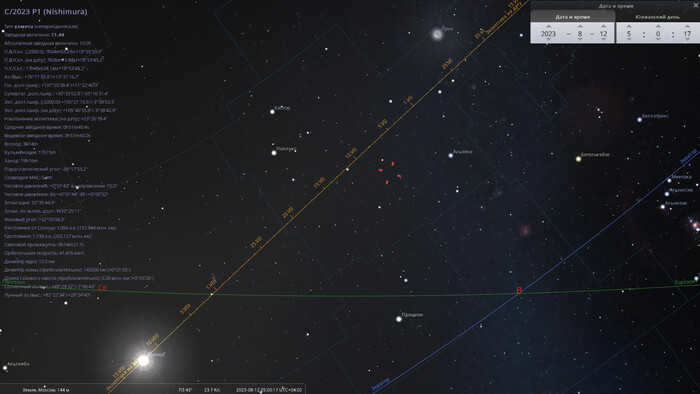
On the morning of August 12, 2023, the comet C/2023 P1 was located in the constellation Gemini (at the moment of discovery).
However, the brightness of the comet has been increasing with each passing night. Now, a week later, it has already surpassed 10 stars in brightness. It is now visible through medium-power amateur telescopes. Although it is still best seen before dawn, the overall viewing conditions have improved slightly since its initial discovery.
What Comes After?
By September 18, 2023, the comet is set to reach its perihelion, the point in its orbit that is closest to the Sun. At this stage, it will be a mere 33 million kilometers away from its scorching surface, which is about twice as close as Mercury. However, unlike Mercury, which is a solid rock, the comet is primarily made up of ice. As a result, the ice will begin to actively melt and vaporize well before reaching perihelion. In fact, this process is already underway, with astronomers observing a small tail, measuring only 8-10 angular minutes in length. This tail consists of gases and dust emitted from the comet’s heated nucleus.
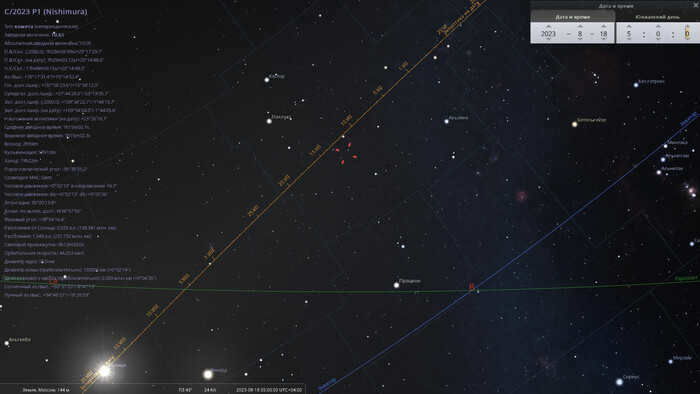
The position of comet C/2023 P1 in the constellation Gemini will be observed on the morning of August 18, 2023
At present, the comet is currently traversing the Earth’s orbit and is situated on the opposite side of the Sun. As a result, there is a significant distance between the Earth and the comet, measuring one and a half astronomical units. However, this situation is rapidly changing.
By early September, the distance between the Earth and the comet will decrease to one astronomical unit (while the distance between the comet and the Sun will be half an astronomical unit). Although the angular distance from the Sun (elongation) will slightly decrease from 35 to 30 degrees, this inconvenience will be offset by the increasing difference in declination between the Sun and the comet. In fact, the comet’s tail will become visible directly above the Sun, allowing for optimal visibility before sunrise.
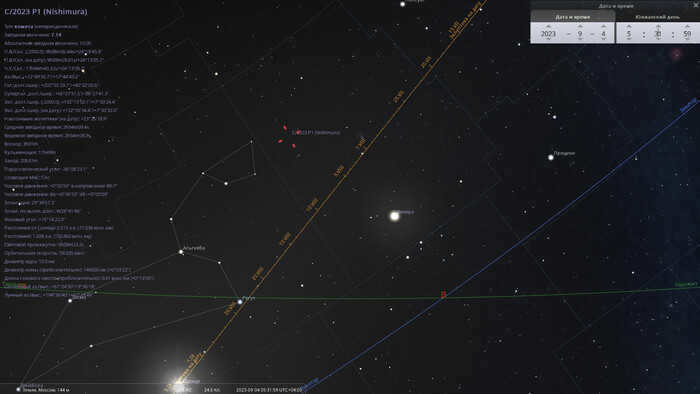
The position of comet C/2023 P1 in the constellation of Cancer on September 4, 2023
In the night sky, you can find comet C/2023 P1 Nishimura in the constellation of Cancer, close to the border with the Leo constellation (look for the asterism known as the “Lion’s Head” for easy identification). Additionally, the bright planet Venus will also be visible in the same constellation. On September 4, 2023, the comet will reach a brightness of 7th magnitude, making it easily observable with binoculars.
Comet C/2023 P1 is expected to come within 1 degree (west) of the star Adhafera (Zeta Leo) on the morning of September 9, 2023. During this time, the comet’s brightness is anticipated to reach a magnitude of 6th star. If you find yourself in an area with ideal conditions such as mountains, desert, or steppe, you may be able to spot the comet with your naked eye.
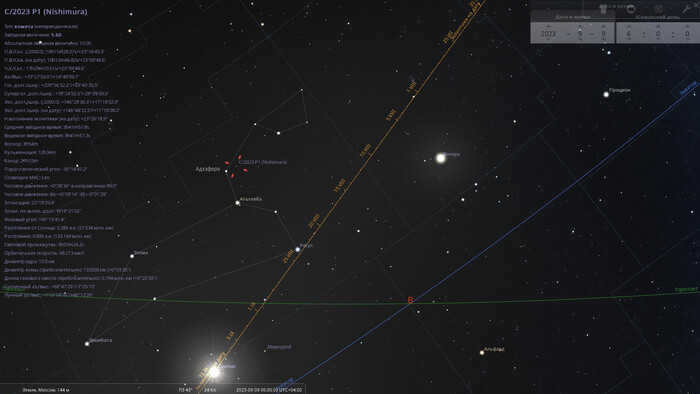
On the morning of September 9, 2023, comet C/2023 P1 can be found in the constellation Leo.
Regrettably, the distance between the Sun and the comet will be reduced to 22 degrees, but the comet will ascend even higher above the ecliptic. Despite this small elongation, the comet will remain visible for at least one and a half hours, and possibly up to two hours.
In the following days, the brightness of the comet will continue to increase. However, the distance between the Sun and the comet will decrease, making it more challenging to observe.
By September 12th morning, the comet’s brightness will reach a magnitude of 5 stars, and its elongation will decrease to 17 degrees. Simultaneously, the comet will remain visible above the Sun, providing an opportunity to spot it in the morning twilight near the star Zosma (Delta Leo).
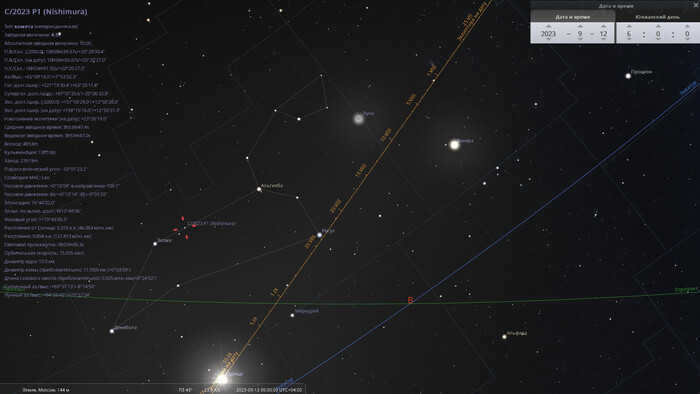
The comet C/2023 P1 will be located in the constellation Leo on the morning of September 12, 2023.
By September 15, the comet will be in close proximity to Denebola (Beta Leo), a star of the 2nd magnitude. The comet’s brightness will be slightly lower, at around 3rd magnitude. Observing both celestial objects will be challenging due to the relatively bright dawn sky.
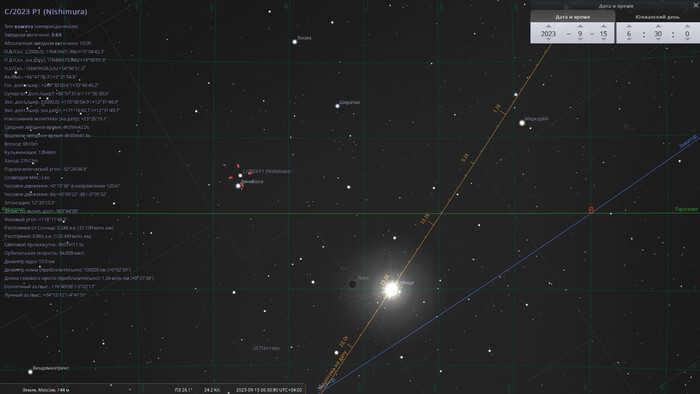
The constellation Leo is where the comet C/2023 P1 can be found on the morning of September 15, 2023.
During perihelion, it is predicted that the comet will have a brightness of approximately 2nd magnitude. In the evening, the comet will only be visible for a few minutes after dusk in the northern part of the constellation Virgo in the northern hemisphere. In the southern hemisphere, it will be extremely difficult or impossible to observe the comet due to its higher declination compared to the Sun.
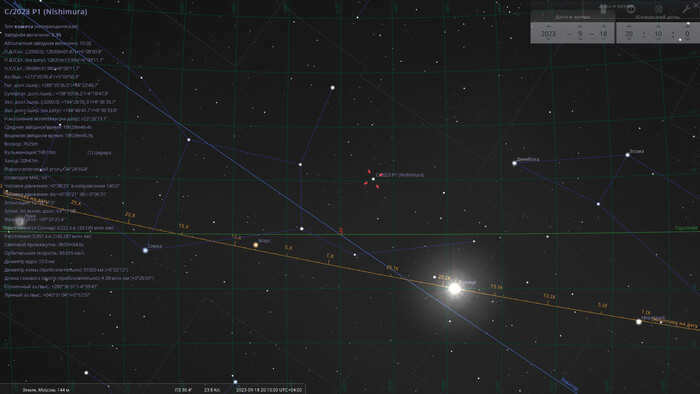
On the evening of September 18, 2023, comet C/2023 P1 (Nishimura) will be located in the constellation Virgo as it passes perihelion.
As the days go by, the comet will gradually move further into the southern celestial hemisphere and will cross the equator almost at the same time as the Sun, specifically on September 21, 2023, the day before the autumnal equinox. At this point, the comet’s brightness will decrease to 4.5m.
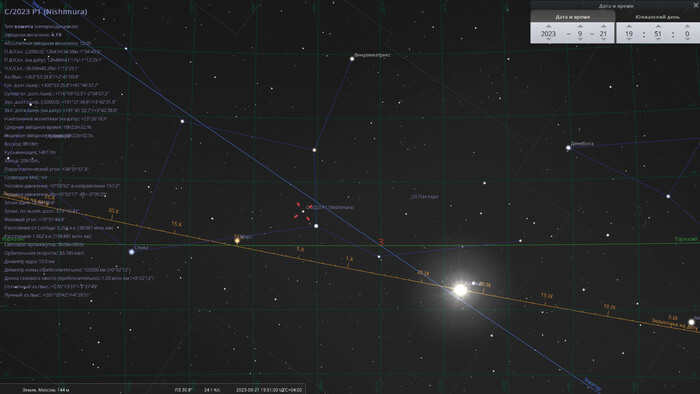
The location of comet C/2023 P1 in the constellation Virgo on the evening of September 21, 2023
On the evening of October 1, you can spot Comet C/2023 P1 Nishimura in the evening, 40 minutes after sunset, at the border of the Virgo and Raven constellations. However, this can only be done if you are in Australia or the mid-latitudes of South America, or perhaps the southern tip of Africa. The comet’s brightness will only be around 7.5m, so it may not be worth buying tickets just to see it.
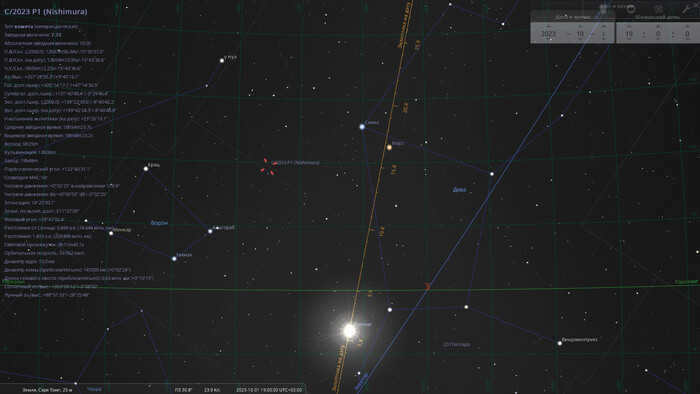
On the evening of October 1, 2023, the comet C/2023 P1 will be located on the border of the constellations Virgo and Raven for observers in Cape Town, South Africa.
As we approach mid-October, the comet will continue its journey further south, entering the tail section of the Hydra constellation. Its light will dim to the 10th magnitude, making visibility conditions even in the southern hemisphere of the planet unsatisfactory. In fact, at this stage, the comet will no longer be visible to astronomy enthusiasts around the world.
When will the comet come back?
Not during our watch. At this moment, the approximate orbital elements have been determined. This level of accuracy is sufficient to calculate the comet’s position in the sky for the next few months. However, the period of its orbit remains unknown. Despite being classified as a long-period comet, its orbit is believed to have an eccentricity of one, meaning it is close to being parabolic or even parabolic. As a result, the comet may return to the Sun in a million years or perhaps never.
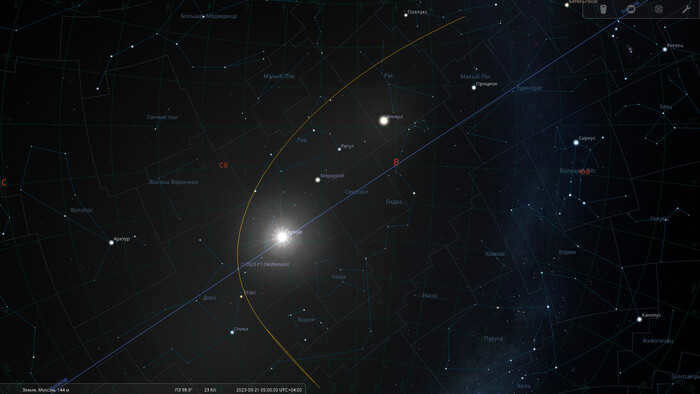
The path followed by comet C/2023 P1 Nishimura from August 12 to November 1, 2023.
These maps have been created using the Stellarium software.

The Galaxy of Orion’s Constellation
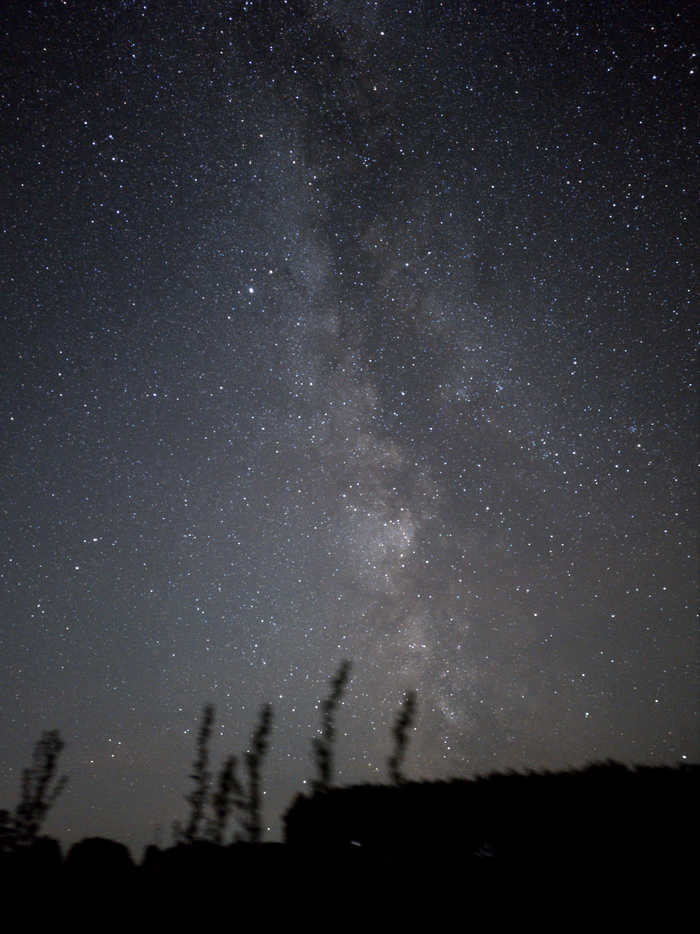
There are 10 images taken with a shutter speed of 15 seconds and an ISO of 3200.
The photos were captured using a Samsung s20fe smartphone in the green zone of the Southern Urals.
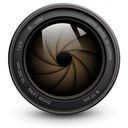
Exploring the Wonders of the Milky Way
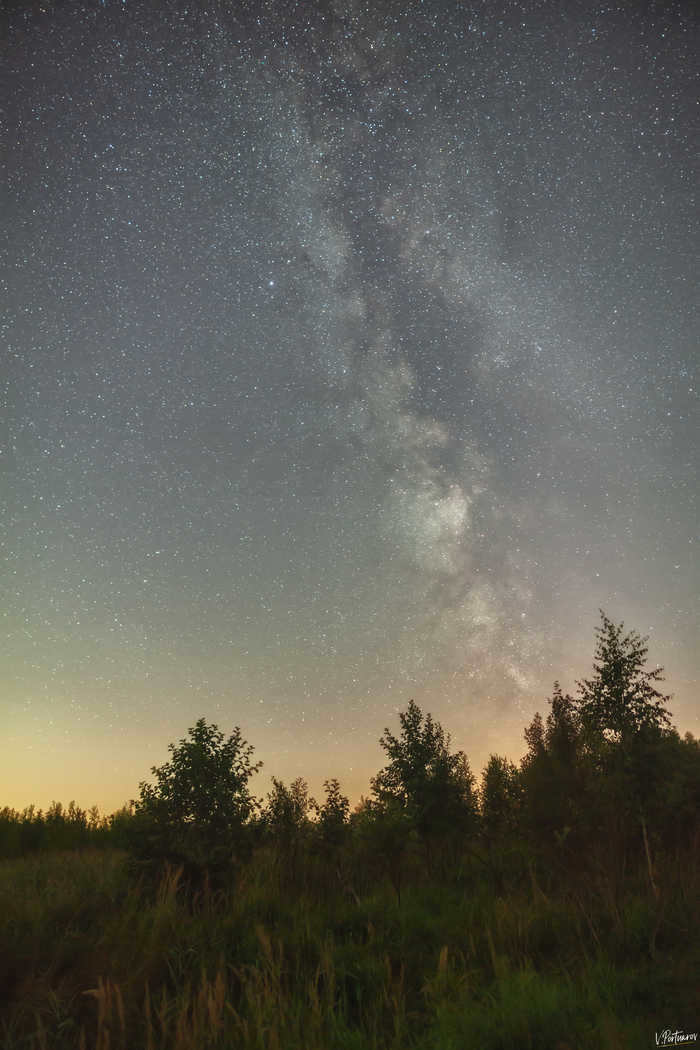
Cassiopeia
The constellation Cassiopeia is located 80 km away from Minsk. The photograph was taken with a Nikon d80 camera and a Nikkor 50mm 1.8 lens.
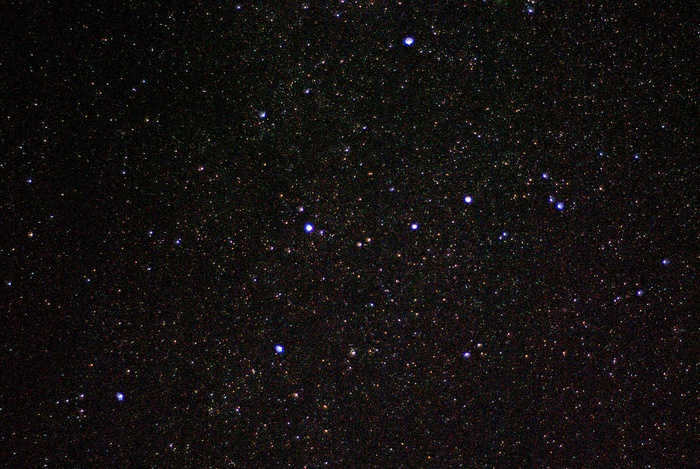

Andromeda Galaxy
I made my first attempt at capturing an image of the Andromeda Galaxy through a telescope, but unfortunately, things didn’t go quite as planned. During a 30-second exposure, a dark cloud obstructed the view, resulting in a less than satisfactory photo. However, I did manage to capture a much clearer image using a tripod and a 50mm lens. If anyone has experience with astrophotography through a telescope, I would greatly appreciate some advice on how to achieve better results. I am currently using a budget-friendly Celestron 70lt az telescope.
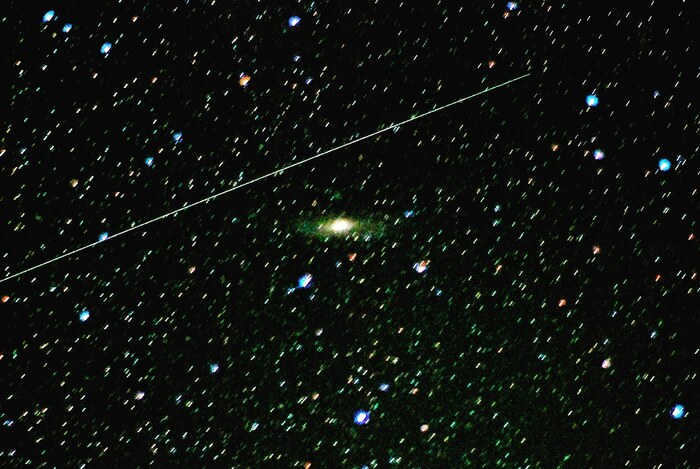
Discover the most desirable properties in our solar system
In 1957, the Soviet Union made history by launching the very first artificial satellite. Over the years, numerous space agencies, private companies, and research institutes have joined the race to explore the solar system. The extent of their achievements is truly remarkable and impossible to fully enumerate. While there seems to be ample space for everyone in this vast expanse, certain elements of local “real estate” are undeniably more alluring than others. One such example is the Lagrange points, which have captured the attention of all interested parties. These points, named after an 18th-century mathematician who discovered them, possess exceptional value as stable islands in our turbulent and ever-evolving cosmic neighborhood.
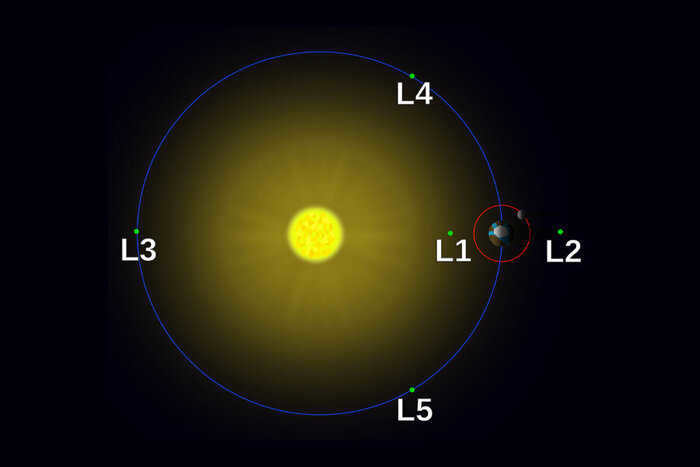
All celestial bodies exert a gravitational pull on each other, with nearby objects being particularly affected. In these systems, other forces also come into play, influencing the shape of the orbits of the objects in motion. These forces find a balance at certain points known as Lagrangian points. If an object with a relatively small mass is placed at one of these points, it will remain at a fixed distance from the larger bodies, creating stable regions in space. These regions are often referred to as cosmic parking lots, as objects within them require minimal energy to maintain their position. In essence, they provide an ideal location for man-made objects intended for long-term space missions.
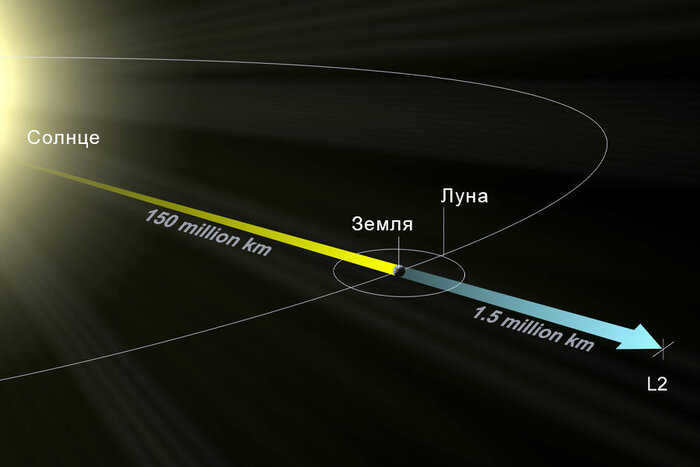
The issue of determining the specific contents that can be accommodated within a given Lagrangian point is of great intrigue. Let us examine those arising from the gravitational interaction between the Sun and the Earth. L1 resides in the space between these two celestial entities, roughly 1.5 million kilometers away from our planet. Given that it provides an unobstructed view of the star, it serves as a perfect vantage point for observing the Sun.
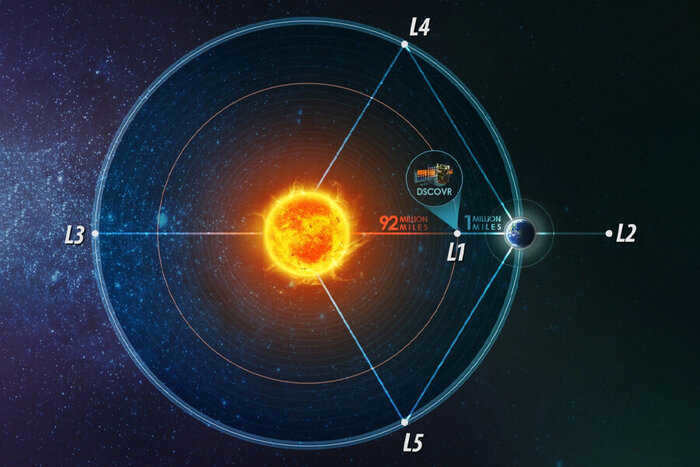
The Deep Space Climate Observatory is a spacecraft from the United States designed to observe the Sun and Earth, and it is located at Lagrangian point 1.
L2, situated on the opposite side of the Earth at the same distance, offers a secure shield from sunlight, providing unique opportunities for space observation. In 2022, the James Webb telescope, eagerly anticipated by astronomers for two decades, commenced its operations from this location.
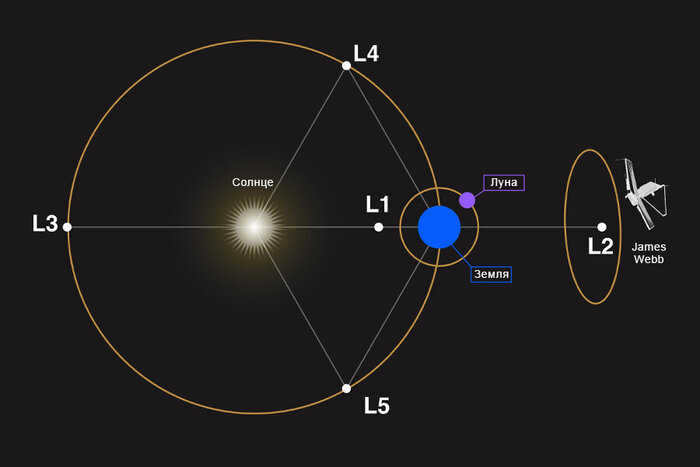
L3 is located in the most enigmatic region, precisely opposite to the Sun’s position in Earth’s orbit. It occupies a unique position in the cosmos, remaining invisible even in theory from any planetary surface. Although L3 is often a subject of fascination for science fiction authors, scientists themselves find it of limited practical value.
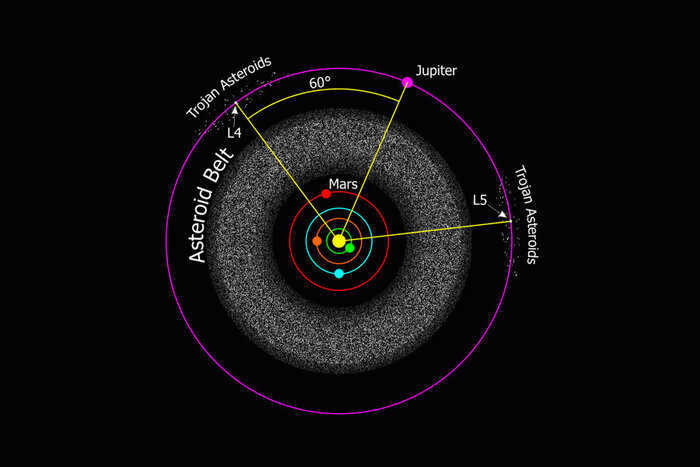
Each Lagrangian point in the solar system possesses its own unique characteristics. Some of these points have the potential for gathering construction materials, envisioning them as drifting asteroids. Other points could serve as locations for refueling stations to replenish the fuel supply for spacecraft voyaging into the vastness of outer space. It is even possible that human colonies could be established and “suspended” at these points. Naturally, this is a matter of the distant future, a future that we may not live to witness given the current state of affairs on Earth. Nevertheless, it is always good to dream, isn’t it?
We appreciate your attention! If you enjoyed this article, you have the option to show your support by giving it a “plus” or subscribing to this channel. We would also like to take this opportunity to mention that we have our own Telegram channel, where we regularly share fascinating posts about space and astronomy.
We are truly grateful for every single one of our readers. In case you wish to provide us with financial support (by utilizing the button provided below), your name or nickname will be mentioned at the conclusion of our upcoming publication. This is our small gesture to express our gratitude for your generosity and encouragement!

The constellation Orion is located in the region of the celestial equator and is known as one of the most prominent [1] and easily recognizable constellations in the night sky [2]. The two brightest stars in Orion are the red star Betelgeuse (Alpha Orion) and the blue-white star Rigel (Beta Orion). This constellation is named after the hunter Orion from Greek mythology.
Brief description
The constellation known as Orion contains two stars with a magnitude of zero, five stars with a magnitude of second, and four stars with a magnitude of third. Among the brightest stars in Orion are several variable stars. In fact, as of 2011, Orion is the second constellation with the highest number of variable stars, totaling 2777. One of the most recognizable features of Orion is its belt, which is made up of three blue-white stars. These stars are named Mintaka (δ Orion), which translates to “belt” in Arabic, Alnilam (ε Orion), which means “thread of pearls,” and Alnitak (ζ Orion), which means “girdle.” The three stars are evenly spaced and form a line that points southeast towards the blue star Sirius (located in the constellation Canis Major, next to Alnitak) and northwest towards the red star Aldebaran (located in the constellation Taurus). The brightest stars in Orion are Rigel, Betelgeuse, and Bellatrix. Additionally, Orion is also home to the Great Orion Nebula, which can be seen with the naked eye.
Betelgeuse
Betelgeuse, also known as α of Orion, is a red supergiant star. Its Arabic name, “Bayt Al Jawzza,” translates to “Hand of the Central” (although it is commonly interpreted as “armpit” due to a distorted form). This star is classified as an irregular variable star, meaning its luminosity varies from 0.2 to 1.2 stellar magnitude, with an average of 0.7 m. Betelgeuse is located approximately 650 light-years away from Earth and has a luminosity 14,000 times greater than that of the Sun. It is considered one of the largest stars in the known universe. In fact, if Betelgeuse were to replace the Sun, it would fill the orbit of Mars at its minimum size and extend to the orbit of Jupiter at its maximum size. The volume of Betelgeuse is estimated to be at least 160 million times that of the Sun.
Rigel
Rigel is a brilliant star located near the equator, specifically in the β Orion constellation. It is classified as a blue-white supergiant. The term “Rigel” derives from Arabic and means “foot,” referring to its position in the Orion constellation. With a visual stellar magnitude of 0.12 m, Rigel is highly luminous. It is situated approximately 860 light-years away from the Sun. Rigel’s surface temperature is measured at 12,130 K, and it falls under the spectral class B8I-a. The star has a diameter of around 103 million km, making it 74 times larger than the Sun. Its absolute stellar magnitude is -7.84 m, indicating that it is exceptionally bright. Rigel’s luminosity surpasses the solar luminosity by approximately 130,000 times, making it one of the most powerful stars in the Galaxy. In fact, Rigel is considered the brightest star in the sky with such a significant luminosity, given its proximity.
During ancient times, the Egyptians associated Rigel with Sah, the king of the stars and the patron deity of the deceased. Later on, Rigel became linked to Osiris as well.
Additional items
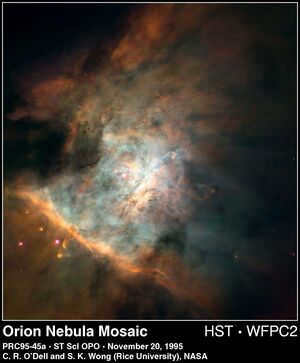
Orion’s Sword contains a famous multiple star system known as Orion’s θ. This system consists of four bright stars arranged in a small quadrilateral, forming what is known as Orion’s Trapezium. Additionally, there are four other fainter stars in this system. All of these stars are very young, having recently formed from interstellar gas within an invisible cloud located in the eastern part of the constellation. Only a small portion of this cloud, which is heated by the young stars, can be seen under Orion’s Belt using a small telescope or binoculars. This visible portion appears as a greenish cloud and is known as the Great Orion Nebula (M42). The nebula is located approximately 1,500 light-years away and has a diameter of 20 light-years, which is 15,000 times larger than the diameter of our solar system. It holds significant interest for astronomers and was the first nebula to be photographed by Henry Draper in 1880.
Located 0.5° south of the eastern star (ζ Orion), you can find the famous dark Horsehead Nebula (B 33), which stands out against the bright background of nebula IC 434.
Asterisms
The asterism called Sheaf is what gives the constellation its characteristic shape. It consists of the stars α (Betelgeuse), β (Rigel), γ (Bellatrix), ζ (Alnitak), δ (Mintaka), and κ (Saif). Another name for this asterism is Butterfly.
There are four asterisms associated with different parts of the traditional constellation figure.
Orion’s Belt refers to the stars Mintaka, Alnilam, and Alnitak (Orion’s δ, ε, and ζ, respectively). It is also known as the Three Kings, Three Magi (Magi), Three Marys, and the Rake.
Sword of Orion is an asterism that includes two stars (θ and ι) and the Great Orion Nebula.
Orion’s Shield is a grouping of six stars that are arranged in an arc: π 1 , π 2 , π 3 , π 4 , π 5 , and π 6 . It was known in ancient times as Tortoise shell.
Orion’s club is another grouping of stars located in the northern part of the constellation. It consists of the stars χ 2 , χ 1 , ν, ξ, and 69 .
Interestingly, the next two groupings of stars actually contain the same stars.
The mirror of Venus is an asterism that includes the stars η, δ, ε, ζ, θ, and ι of Orion. It is formed by the Orion’s Belt asterism, the star that represents the Sword handle, and the star η of Orion. The Sword of Orion asterism itself acts as the handle of the mirror, creating a diamond-shaped reflection.
A fresh constellation called The Saucepan was discovered by amateur astronomers in Australia. In the southern hemisphere of our planet, celestial objects, including constellations, can be seen in a reversed orientation compared to their appearance in the northern hemisphere. As a result, the asterism known as the Mirror of Venus is seen upside down: its handle becomes the handle of the Pot, while the remaining stars form the body of the Pot. This asterism consists of the stars η, δ, ε, ζ, θ, and ι in the Orion constellation.
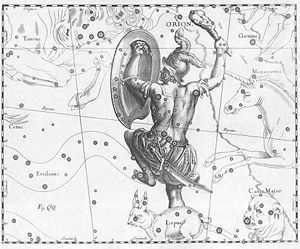
Observation
In the mid-latitudes of the northern hemisphere, the constellation can be observed during the late summer months (beginning in mid-August), as well as during the fall, winter, and the first half of spring (until mid-April). The optimal time for observing the constellation is from November to January, when it is visible from sunrise to sunset. The constellation can be seen all across Russia. It is classified as an autumn-winter constellation based on the seasonal classification.

Origin
The earliest recorded depiction of the constellation Orion can be traced back to a prehistoric carving on a mammoth bone discovered in a cave in the Ach Valley in West Germany in 1979. This artifact, estimated to be 32,000 to 38,000 years old, is believed to be the oldest image associated with Orion [5] [6] [7].
The arrangement of stars in the constellation resembles the figure of a man. In Ancient Egypt, Orion was known as Sah and was worshipped as the embodiment of Osiris, the “king of the stars.” During the New Kingdom era, Orion-Sah was often depicted sailing on his boat towards the stars [8].
Ancient Babylonians referred to Orion as the “Heavenly Shepherd” or the “Faithful Shepherd of Anu,” associating it with the god Papsukkal [en] [9].
In Jewish (and biblical – Amos. 5:8) tradition, the constellation known as Kesil or Kesil (Hebrew כסיל, meaning “fool”) is believed to correspond to Orion. The origin of the name Kesil is still unknown, but some suggest that it may be derived from the Hebrew month of Kislev (which falls in November-December). Kislev itself comes from the Hebrew root K-S-L, which also appears in the words “kesel” and “kisla” (כֵּסֶל, כִּסְלָה), meaning “hope.” This connection implies that Kesil represents hope for winter rains. In the biblical Book of Job (Job. 38:31), Orion (Kesil) is mentioned as being immobile in the sky, while the Pleiades (Hime) are described as being “dispersed.” The verse asks, “Can you tie the knot of Hyme and resolve the bonds of Kesil?”
According to Greek mythology, the constellation was observed in Orion, the renowned hunter, who was believed to be the son of Poseidon and Euryala. After Orion’s demise from the arrows of the goddess Artemis (or, according to an alternative version of the myth, from the sting of Scorpio), his father Poseidon placed him in the sky.

The constellation was known as Kruzhiliya or Kolo in ancient Russia [10] [11] .
In Armenia, the constellation of Orion is referred to as Hayk in honor of the patriarch ancestor of the Armenians. According to traditional beliefs, the light of his soul ascended and froze in the sky, forming the constellation with the same name.
In Inca civilization, the constellation was named Chakra [12], while the belt of Orion was called Pata by the people of the Chimu kingdom, which was part of the Inca Empire. This name means “Captured“, as it was believed that the two outermost stars were sent by the moon to seize the middle star, like thieves and criminals, and they were captured by the “Gryphons“, which are represented by the four stars below and above in the constellation [4].
Orion is depicted alongside the Sun, Cassiopeia, Swan, Gemini, Pegasus, and Pleiades on a ceramic vessel from the Vuchedol culture discovered near Vinkovci, Croatia (3000-2600 BC) [14].
In the Bible
Orion (Dr.-Greek Ώρειων ) [15] – according to the Septuagint, corresponds to the Hebrew word Dr.-Heb. ליםב (Is. 13:10; Job. 38:31; in Job. 9:9 – The Septuagint, however, translates the Dr. Greek. Έσπερος as “evening”, the star Hesperus) [15].
The Targum and Peshitta translations of the Bible interpret this word as “giant”, and the Armenian translation assigns the name of the constellation to the ancestor of Armenians, Hayk [15].
Mentioned in Job. 38:31 as “the bonds of Kesil” (Hebrew זיםב תובשומ ; synodal translation: “the bonds of Kesil”), some scholars believe that this refers to the popular ancient concept of Orion as a giant chained to the sky. In Hebrew, it may have been called ליםב, meaning “godless” or “foolish.” According to these scholars, the “loosening of the bonds” mentioned in the Book of Job refers to the release of the giant described in the myth. However, Dillman suggests that it is actually a bridle, which, when lowered, causes the constellation Orion to appear higher or lower in the sky depending on the seasons (in Syria, Orion appears 17° higher on the horizon compared to Europe). Others argue that תובשומ refers to the three brightest stars known as the “staff of Jacob” or “Orion’s belt.” However, the word תובשומ does not quite match the meaning of “belt.” [15]
According to Byzantine church writers, the Persians believe that Orion is the giant Nimrod who is chained to the sky. This aligns with the fact that the Syrian Arabs refer to Orion as “gabbârun” (meaning “rich man” in Hebrew), which is also applied to Nimrod in Genesis 10:8, 9 [15].
Jewish medieval scholars (such as Saadia, Isaac ibn-Jikatilla, and ibn-Janah) state that the word “ליםב” is similar to the Arabic word “Suhêl” and refers to either Sirius or Canopus [15].
Related Content
Important Information
- ↑ Chisholm, Hugh, ed. (1911), Orion, Encyclopedia Britannica, vol. 20 (11th ed.), Cambridge University Press, p. 276.
- ↑Dolan, ChrisOrion(unpublished). . Date of access: November 28, 2011.Archived December 7, 2011.
- ↑Siegel F. Yu. Treasures of the celestial sky: Guide to constellations and the Moon. – 5th ed. – M. : Nauka, 1987. – p. 119. – 296 p.
- ↑ 4,04,1 Antonio de la Calancha. Moralized chronicle of the Order of San Agustín in Peru. (Barcelona, 1639). – Volume 3. – p. 15.
- ↑A 32,000-year-old ivory plate may depict the constellation Orion along with a pregnancy calendar // (IXth Annual Meeting of the European Society for Astronomy in Culture (SEAC)). – Uppsala Astronomical Observatory. – P. 51-55.
- ↑The decorated plate from Geißenklösterle, Germany(unpublished). . UNESCO: Portal to the Heritage of Astronomy.. Date of access: February 26, 2014.Archived February 13, 2022.
- ↑Whitehouse, David. ‘Oldest star chart’ discovered, BBC (January 21, 2003). Archived March 12, 2021.Accessed February 13, 2022.
- ↑Sah – constellation and godArchived April 15, 2015 at the Wayback Machine.
- ↑J. H. Rogers.Origins of the ancient constellations: I. The Mesopotamian traditions(The Mesopotamian traditions.) // Journal of the British Astronomical Association(English) ( Russian . – British Astronomical Association(English) ( Russian. , 1998. – February ( vol. 108 , no. 1 ). – P. 9-28 . – ISSN0007-0297. – Bibcode: 1998JBAA..108. 9R . Archived August 9, 2017.
- ↑ Sreznevsky I. I. Materials for a dictionary of the Old Russian language based on written monuments. Т. 1. St. Petersburg. 1893. С. 294-295, 1334.
- ↑Д. Churakov.Enigmas of matriarchy: Anthropogenesis, history, myth: a monograph(Bulgarian).. – Prometheus, 2017. – С. 69. – ISBN 978-5-04-095765-1.
- ↑ Pablo José de Arriaga. The eradication of idolatry in the Piru. – Lima: Geronimo de Contreras, 1621. – p. 130.
- ↑ Karpenko Yu. A. Names of the celestial sky. – M.: Nauka, 1985. Pages 45-46.
- ↑ Oldest European calendar ‘deciphered’(unpublished)(unavailable link). Date of access: February 28, 2015.Archived December 1, 2008. , May 22, 2001, Independent Online.
- ↑ 15,015,115,215,315,415,5Orion // Jewish Encyclopedia of Brockhaus and Efron. – St. Petersburg. , 1908-1913.





